

PLS&TY > DAXSON
ALPHATHETA DDJ-FLX2
SHURE MV7i MIC/INTERFACE
EMAIL-MARKETING ADVICE
MENTOR MOVES TOP TALENTS’ CAREER TIPS



PLS&TY > DAXSON
ALPHATHETA DDJ-FLX2
SHURE MV7i MIC/INTERFACE
EMAIL-MARKETING ADVICE
MENTOR MOVES TOP TALENTS’ CAREER TIPS

Just as the legendary K Series quickly became the New Standard for powered loudspeakers, the K Column is destined to forever elevate customer expectations from a column loudspeaker. It’s the perfect combination of sleek and stylish design, coupled with the acoustic performance of a high output, high fidelity loudspeaker system.
· 3000-watt Power Amplifier
· QSC LEAF™ Waveguide (first introduced in the L Class line array)
· Wide 145-degree Horizontal Coverage (35-degree vertical)
· Advanced DSP Presets and Processing
· Bluetooth® True Wireless Stereo Capable
· 6-Year Warranty (with product registration)



By Jim Tremayne
Atlantic City, N.J. – Get set, DJs, because DJX ’25 is coming your way… with its 35th anniversary edition.
Scheduled for August 11-14 at the Hard Rock Hotel & Casino in Atlantic City, N.J., DJX will gather all sets of the DJ industry –mobile, club and studio – with its combo of new technologies, education, and sponsored After Dark events.
Produced by DJ LIFE magazine and Hazan Media Group, DJX will present an exhibit hall full of the latest DJ-related products (audio, lighting, studio, content-creation, accessories, etc.), a slate of 30-plus seminars, panels, and keynotes tackling the most-pressing topics, and nightly parties featuring top DJ talent. Operating since 1990, DJX is the longest-running and most-impactful trade show/ event in the North American DJ industry. At presstime, here’s what the show looks like:
Sunset Sessions: Introduced at 2024’s DJX, the Sunset Sessions will return, offering attendees sponsored, early-evening gatherings with the industry’s top brands featuring music, food/drink, and giveaways. QSC (Aug. 11), AlphaTheta (Aug. 12), and Mackie (Aug. 13) are scheduled with sessions in the Hard Rock that will run 6:30 to 8 p.m.
Sponsored Seminars: As always, DJX will offer several sponsored seminars from brands exhibiting on the showfloor. At presstime, they include sessions from: AlphaTheta/Pioneer DJ (two sessions); Carnival Cruise Line; Max Design; SMPL; Twitch.tv; and Vibo DJ. At these special sessions, attendees will get opportunities to take a deeper dive into these brands’ latest technologies and services, and ask questions directly to company representatives.
After Dark: On Aug. 11, DJX’s opening-night event at HQ2 Nightclub in the Ocean Casino Resort will present an evening with DJ White Shadow, best-known as the Grammy-winning DJ/ producer for hitmaker Lady Gaga.
On Aug. 12, D.A.S. and JetPack will present its “Twisted Tuesday” party at the Hard Rock featuring a pair of top turntablists from The Beat Junkies crew – DJ Babu and Shortkut.
On Aug. 13 at The Balcony in the Hard Rock, Jake Jacobsen and Mike Alevras will host the annual mobile-centric party. This year’s theme is “Sonic Evolution – The 35 Years of DJX” with dancefloor music from the past three-plus decades. Talent includes Matt Radicelli, DJ Larry D, DJ Kid Kasper, and Jimmy Strange. Immediately after the event in the same venue, Mell Starr & Friends will take over and rock the room deep into the night. Talent TBA.
Keynoters: In addition to his opening-night gig at HQ2, DJ White Shadow will participate in DJX’s “Keynote Q&A” series. In an exclusive Q&A session with DJ LIFE Editor Jim Tremayne, the award-winning DJ/producer (aka Paul Blair) will recount his career highlights, including creating hitmaking and award-winning music with Lady Gaga.
Educational Seminars: Florida-based DJ Cova will helm “SocialMedia Strategies for DJs: Attract More Gigs, Earn More Money.” In it, he and online influencers Jack Kristian, Jack Kristian, Justin the DJ, and Cleveland Terry will reveal the secrets to maximizing reach and converting followers into paying clients.
Also, Alex Updike, owner of the Coachella Valley, Calif.-based company Bass & Bliss, will present “Level Up: Making Your Mixes Radio-Ready.” In it, he’ll demonstrate how DJs can showcase their skills and musical tastes by creating DJ mixes for use on radio or Mixcloud.
For the latest on DJX ’24, please visit www.djxshow.com




Detroit – This past May 24-26, more than 90,000 fans jammed the Motor City’s Hart Plaza for the 18th Movement festival – here John Summit closes out the festival on its mainstage. Produced by Paxahau, Movement helped kick off festival season by presenting more than 120 performers, including legendary Detroit talents like Jeff Mills, Kevin Saunderson, and Carl Craig. For more on Movement, please see Page. 26.









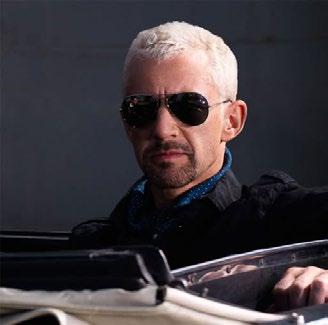








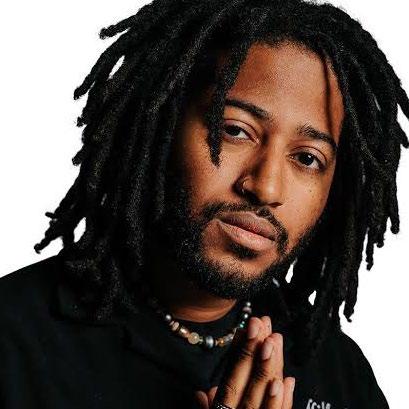


Jim Tremayne
As spring leans into summer, the upper talent tier of the DJ world has begun hitting our most-prestigious stages, some with the most clued-in audiences, others with enormously impressive stage productions. Yes folks, it’s Festival Season 2025, a time when fresh tunes get their debuts, fans lose their minds a little bit, and many of the performing DJs get more live exposure than they’ll see all year.
In this issue, we take multi-page looks at two of America’s most-influential festivals – Las Vegas’ Electric Daisy Carnival presented by Insomniac and Detroit’s Movement presented by Paxahau – which took place two weeks apart this past May. While Motown’s Movement leans more techno and remains a deeply curated affair, it draws a very respectable 90,000 fans to Hart Plaza for its three-day run. Sin City’s EDC, on the other hand, goes big in every way – from its enormous stages and fireworks shows to its record-setting attendance. With 525,000 fans attending its three days, it’s North America’s largest EDM event.
Speaking of big gigs… this issue also takes us to the White Isle of Ibiza where [UNVRS], purportedly the world’s largest nightclub, opened this past May. Hailed as a “hyperclub,” the 70,000-square-foot venue can fit a reported 10,000 patrons into its environs, which feature custom art pieces, mesmerizing LED visuals and lighting, and a custombuilt L-Acoustics sound system. With resident DJs that include Carl Cox, Fisher, David Guetta, Eric Prydz and more, [UNVRS] is off to a great start.
This past March, during Miami Music Week, DJ LIFE served as media sponsor for the EDMAwards, presented by IHeart Radio at the Eden Roc Hotel. While most of the winners and nominees hit press row, we managed to grab a number of these music-making DJ/producers for a couple minutes of valuable time. We asked about their initial musical inspirations and got some career advice for up-and-comers looking to one day create meaningful music and perhaps make a career. Check Page 14 the answers.
This issue also finds us visiting with Sharone Bechor of Manhattan’s legendary DJ store, Rock And Soul DJ Equipment & Records, which is celebrating 50 years in the business this year. Whether it was early hip-hop jocks, veteran house-music DJs or mobiles looking for gear or music, Rock And Soul was always there. As DJX is right around the corner – Rock And Soul will be repping AlphaTheta/Pioneer DJ in Atlantic City – we caught up with Ms. Bechor to discuss the history of the store and some of its famous customers.
In our Sound Bites columns, we visit with two very different DJ/artists. For the In the Studio portion, we connect with U.K. trance jock Daxson (aka Dan Dobson), who explains his studio process and more. Also, our Mark Mancino sits with PLS&TY (Please & Thank You aka Tommy Leas), whose feel-good future-bass jams have lit up clubland and the streaming platforms.
For gear reviews, Twin Cities-based DJ Deets ran AlphaTheta’s DDJ-FLX2 controller through its paces. And with his debut entry to the Studio Session column, we welcome NYC DJ/content-creator Mike Márquez, who handles Shure’s unique MV7i smart mic/ interface.
On the mobile-entertainer side of things, Canadian digital-marketing maven Jordan St. Jacques offers a refresher on email marketing for DJs. Also, we visit with Matt Dodge, a Tampa-based jock, who plays a large portion of his area’s sporting events – professional, collegiate and high-school. Also, you’ll want to check out both St. Jacques and Dodge as they participate in seminars at DJX this coming August.
Speaking of DJX, we offer you the latest updates and we certainly hope to see you this Aug. 11-14. Set for the Hard Rock Hotel & Casino in Atlantic City, N.J., DJX will be celebrating its 35th anniversary, as it presents top seminars, the very latest DJ technologies, and fantastic evening events. For the very latest, please visit www.djxshow.com.
Cheers,
Jim Tremayne Editor, DJ LIFE

editor-in-chief
Jim Tremayne jtremayne@hazanmediagroup.com
editor-at-large Brian O’Connor boconnor@@hazanmediagroup.com
web editor and social media manager Mark Mancino mmancino@@hazanmediagroup.com
contributors
Wesley King, Chris Caruso, Amanda Chavez, Shawn Christopher, Paul Dailey, Reed Dailey, Chris Davis, DJ Deets, Tony Fernandez, Tommy D Funk, Lexi Ferguson. Greg Hollmann, Danielle Johnson, Erik Miller, Lily Moayeri, Jordan St Jacques, Jeff Stiles, Ashley Teffer, Danny Turner, Phil Turnipseed, Joshua Volpe, Travis Wackerly, Curtis Zack
chart coordinator Dan Miller dmiller@hazanmediagroup.com
director of sales Josh Kerman jkerman@hazanmediagroup.com
creative director Janice Pupelis jpupelis@hazanmediagroup.com
director of technologies and project management Steve Thorakos sthorakos@hazanmediagroup.com
Chairperson & COO/Co-Publisher Robin Hazan rhazan@hazanmediagroup.com
President & CEO/Co-Publisher Shawn Hazan shazan@hazanmediagroup.com


visit our website: www.djlifemag.com 516.767.2505
Editorial and Sales Office: DJ Life, Oyster Bay, NY 11771. (516) 767-2505 • (Sales/all other business): (516) 767-2505 • djlife@hazanmediagroup.com.
Editorial contributions should be addressed to The Editor, DJ Life Mag, Oyster Bay, NY 11771 or sent to JTremayne@hazanmediagroup.com.
DJ Life Mag is published bi-monthly starting with the second month annually.
Design and Contents: copyright © 2025 by DJ Life Mag and must not be reproduced in any manner except by permission of the publisher.
Web: DJLifeMag.com DJXShow.com and HazanMediaGroup.com
Subscriptions: Complimentary Digital Edition. Email: djlifemag@hazanmediagroup.com Phone: 516-767-2505 ext. 502 Web: djlifemag.com/subscribe
| VOL.5 NO.3

For the first time ever, Twitch. tv will join DJX in a significant collaboration, bringing its massive DJ-streaming platform to a physical, in-person experience to DJX ’25. Simultaneously, DJX will launch a Twitch channel.
Additionally, on Aug. 12, Twitch will present the “Twitch DJ Program FAQ Panel,” hosted by Jordan Williams and Sydney Golombek. In discussing the Twitch DJ Program – a first-of-its-kind offering that enables DJs to legally livestream the vast majority of popular music – the Twitch staff will walk DJX attendees through platform’s program, from setting up your stream to growing your audience.

offer onboarding incentives on their platform along with the chance to stream on the newly launched DJX channel IRL at the Twitch Creator Studio on the show floor.
As part of the onsite experience, DJs attending DJX’25 will be able to:
Work one-on-one with Twitch staff to set up or optimize their channels.
Earn exclusive “Fast-Pass Access” to Affiliate Status, unlocking monetization tools from the start.
Receive priority review for Twitch Creator Clubs.
This marks Twitch’s first official trade-show activation in the DJ space, and it’s built specifically to help DJs explore real, immediate streaming monetization opportunities. Exclusive to DJX ’25 attendees, the platform will
Learn about post-show support resources and Twitchexclusive offers available only to DJX attendees.
Live stream on the DJX Show channel.
Stream live from DJX ’25 on their own channels.
For the latest on DJX’25, please visit www.djxshow.com.
More than a DJ camp—this is where the next generation of talent finds its voice.
nXt Summer Camp @ DJX is an immersive, hands-on experience designed for aspiring DJs ages 7-20, offering three days of expert-led training, mentorship, and inspiration at the industry’s most influential gathering.





Tommy Leas, better known as PLS&TY, has become a familiar DJ/ producer to many over the past decade. Appreciated for his feel-good future bass sound with tracks like 2023’s “ Your Love ” (feat. Sofiya Nzau) and 2024’s “Just One Touch” (feat. Linney), PLS&TY (pronounced “please and thank you”) recently released his latest melodic effort, Into The Light, a well-crafted, three-track EP on Dim Mak Records
By this stage of his career, Leas has become a chart-topping artist that has amassed hundreds of millions of streams across DSPs – and let’s not forget his feature in a Hershey’s commercial, which has garnered over 1 billion views. When it comes to his very own tunes, PLS&TY’s music has been remixed by the likes of the Grammy-nominated Morgan Page, plus Rusko, Cazzette, Cat Dealers, and Bondax, among others.
PLS&TY’s tour history includes stops at some of the most acclaimed events and festivals within the circuit, including Bonnaroo Music & Arts Festival, Electric Forest, Breakaway Music Festival, and more. Most recently, he played the Forest House stage at Electric Daisy Carnival in Las Vegas this past May. We caught up with the 28-year-old Florida native, Tommy Leas, to discuss the new EP, earliest musical influences, who inspires him most today, how he got his start as a DJ and a producer, his gear preferences, and
more.
DJ LIFE: How did you get your start as a DJ?
PLS&TY: I started by making mixes for friends, whether it be to listen to in the car on the way to shows of other artists or to listen to at the beach. It was all about sharing the music I loved in ways that could bring people together. I wasn’t thinking about performing at the time; it was just pure passion for curating the perfect vibe for any occasion. Eventually, those mixes turned into live sets.
DJ LIFE: What comprised your first DJ set-up? How about your current DJ gear?
PLS&TY: My first DJ setup consisted of a Native Instruments Traktor S4 controller and a laptop. I loved the flexibility Traktor offered, especially for layering a cappellas and stems. Now, my setup is the industry-standard Pioneer CDJ-3000s and a DJM-900NXS2 mixer.
DJ LIFE: Did you get your start as a DJ or producer? Do you prefer one to the other?
PLS&TY: DJing! Production came about naturally thereafter, from an eagerness to become a well-rounded artist and play my own music in a live setting.
DJ LIFE: Who were some of your earliest musical influences? Who inspires you most now and why?
PLS&TY: Some of my earliest musical influences were artists like Flume, Lido, and Wave Racer. They completely shifted my perspective on what electronic music could be, blending catchy melodies with experimen-
tal sound design in such a fresh way. These days, I’ve been drawing inspiration from a range of genres and artists. Brazilian artists Antdot and Maz are ones to watch. They have this ability to create a sound that feels so unique, but incredibly personal, mixing electronic production with natural, live instrumentation.
DJ LIFE: Do you have a process in the studio?
PLS&TY: I don’t truly have a set creative process. Often, inspiration comes to me out of the blue. It’s in those moments where something randomly sparks that I jump on and start working on the idea.
DJ LIFE: Can you share a bit about how you got your production start and what your studio set-up was like?
PLS&TY: In the beginning, my production setup consisted of just a laptop, monitors, and a MIDI keyboard. Back in 2014, when the PLS&TY project first started, I started out by remixing classic R&B and hip-hop tracks like Outkast’s “Roses” and Nelly Furtado’s “Promiscuous ” I developed a unique workflow by building entirely original instrumentation around a cappellas, which really shaped my approach to production and performance. Even as I transitioned into releasing original music, that same method carried over, as vocals have always been the centerpiece of my work and continue to drive the emotion and structure in all my tracks.
DJ LIFE: What’s your DAW now? Some of your
go-to plug-ins, software, hardware, etc.?
PLS&TY: My DAW is Ableton Live, and my go-to plug-ins right now are Waves SSL E-Channel, Soundtoys Little AlterBoy, SPL Vitalizer, A.O.M. Stereo Imager, Xfer Records LFO Tool, and XNL Audio RC-20 Retro Color.
DJ LIFE: Do you have any pre-show routines or rituals?
PLS&TY: I don’t have an exact pre-show routine. It’s more about surrounding myself with people who bring positivity and the right type of energy. As long as I find myself surrounded by good vibes, I’m ready to go.
DJ LIFE: Your newest EP, “Into The Light,” was just released through Dim Mak. What can you share with us about the project?
PLS&TY: “Into The Light” is an emotional reflection of the human experience, and that’s something I really wanted to capture throughout the EP. Each track speaks to moments we all encounter – whether it’s heartbreak, uncertainty, or the enduring power of love and connection.
DJ LIFE: And your process of putting it together?
PLS&TY: The creative process was about tapping into these universal emotions, making something that people could truly relate to. I want listeners to feel like they’re not alone in their struggles. This EP is for anyone who’s ever needed a reminder that the light is still there, even in dark times – it’s just waiting for you to find it and step into it. Every song on this project

represents that journey of moving from darkness into something brighter, and I hope it resonates with people on that deeper level.
DJ LIFE: How long were you working on this EP and how did you go about choosing which cuts would make the tracklist?
PLS&TY: I spent about a year working on “Into The Light.” When it came to choosing which tracks would make the final tracklist, I focused on how each song contributed to the overall narrative of the EP. Every track represents a part of that journey from darkness into light.
DJ LIFE: As a touring artist, which of your recent shows stand out most to you and why?
PLS&TY: All of my recent headline shows have been exceptional, but what really stands out to me is the connection I’ve had with the fans. I’ve had people in the crowd holding up their phone with my entire discography saved on Spotify, waiting until the end of the show just to have a moment and tell me how much the music means to them. These personal interactions are moments I’ll never forget.
DJ LIFE: Looking back on your career thus far, have you had any gig horror stories?
PLS&TY: Electric Forest 2019, in Michigan I realized my USB had completely corrupted the song files – nothing would load properly. I had to scramble to find any track that would actually play, piecing together whatever I could find.
DJ LIFE: What are some things on your bucket list? Short-term and long-term goals for PLS&TY?
PLS&TY: Quite simply: More live shows, more music, and more lifelong memories. I want to keep traveling the world, connecting with fans, and experiencing new places through music. I want to leave a lasting impact with the music I create. Hopefully, my music will resonate with people for years to come.
– Mark Mancino
U.K. talent Daxson holds a unique place in the modern trance world. Touring and making music for a variety of labels like Coldharbour and Black Hole since 2017, the Manchester-based DJ/producer has created a diverse mix of tunes that has livened up the scene.
From 2018’s powerful “Blackcard,” which fused melodic trance with tough techno elements, through his uplifting 2022 Face the Future album to 2025’s hypnotic collab with JKult, “Beyond Belief,” Daxson (aka Dan Dobson) hasn’t stopped producing genre-topping tunes.
As he readied his latest single, the celestial “Aurora,” on Bebé Recordings, Daxson connected with DJ LIFE and we discussed his career and his musical pathways.
DJ LIFE: Musically, what were your first influences, the ones that impacted what you’re doing now?
Daxson: It was when I discovered the trance that was released in the early 2000s and late 1990s. I just had a passion for trance music from an early age. Later in life, when I moved to Manchester, I rediscovered the genre, embracing the music scene in the city. From there, the passion grew into an obsession with a long journey learning to make the music I loved.

DJ LIFE: How does a Northern lad become so mad for trance?
Daxson: I would listen to trance compilation CDs when I was on family holidays. Trance music and amazing scenery is a nice recipe. Later, when I moved to Manchester, trance events were on pretty much every week somewhere in the country.
DJ LIFE: Why do you think trance fans are so dedicated? What is it about the music and the scene?
Daxson: Trance is a genre you feel. I think people resonate with it because it has the ability to change your mood for the better. It becomes a part of your life.
DJ LIFE: How did you begin your DJing? What gear did you get and what were your first gigs like?
Daxson: My first decks were Gemini belt-drives. My first gigs came some years later. I quickly became a resident at Rong in Manchester when it was at Venus nightclub. I learned my craft in these years, from playing my first set in Room 2 to warming up the main room before the brand moved to Victoria Warehouse, a much bigger venue, where again I got plenty opportunities over the years playing to thousands. The residency gave me a lot of experience behind the decks, for which I’m very grateful.
DJ LIFE: When did you begin to create music yourself? At what point did you become confident with your productions or remixes?
Daxson: I studied music production at Manchester MIDI School – now School of Electronic Music. During this course, I had access to their studios, which I took advantage of, using them every week day. I didn’t become confident with my productions until artists I looked up to started to play them in their sets.
DJ LIFE: How did you pursue your career in music? What worked best for you in getting your first breaks?
Daxson: Pretty much putting all my eggs in one basket and working every day towards my goals, whilst not giving up. I had a somewhat fortunate turn of events quite early on. Towards the end of my Music Production Course, I crossed paths with the promoter of Rong, as I was leaving the college one day. It turned out he was looking for someone to share his studio with while I was searching for one to use after the course ended. This eventually led me to become a resident at Rong, as well as leading me to my studio, which I still have today.
DJ LIFE: From your main studio gear, what’s your DAW? Monitors? Vital hardware? Fave plug-in?
Daxson: I use [Apple] Logic 11 to produce. I have been using ADAM Audio A7X monitors since around 2015, but last week switched to Genelec 8040B – I’ve have wanted these for a while. I was using my [Access] Virus TI2 for many years, but since upgrading my MacBook, I’m no longer able to use it. However, these days, I prefer the soft synths – [Xfer Records] Serum 2 and [Reveal Sound] Spire are my go-to plug-ins.
DJ LIFE: Do you have a routine for creating music? Is there a process that works best for you?
Daxson: For me, it’s always writing the main melody or creating an idea for the breakdown at first. Once I have that, it’s easier for me envision how the rest of the track should sound before I start to produce it.
DJ LIFE: How do you approach collaborations? How do you choose people to work with?
Daxson: I’ve recently done a collab with Craig Connelly, for example. He came to me with an idea, then we spent a

day in my studio producing it. Then we took the stems to his studio where we went over the mixdown and changed some of the intro/outro elements. We’re both really happy with how it’s turned out and excited to start playing it in our sets.
DJ LIFE: Which producer/remixers are you appreciating these days and why?
Daxson: I’m really inspired my some of the hybrid techno producers right now, like HI-LO and Space 92. They’re releasing really interesting tracks that have a lot of energy.
DJ LIFE: Creatively, how did you approach “Beyond Belief,” your latest single with JKult? It’s got some really overwhelming sounds. What was that process in the studio?
Daxson: Thank you. For this collab, I teamed up with Jake Holt, who is an incredibly inspiring guy. He is a blind producer and doesn’t let that stop him from writing and producing music. He came down the studio one day and he was playing melody after melody, some already-known tracks and some that he was creating after being inspired by what he had just played. We spent an hour or so going through different sounds, then writing melodies inspired by the sounds. Once we had the main riff, the demo version was produced in the same day. After that, we used Dropbox to share the project. I’d work on it all day, then Jake would work on it through the night. Over the course of a few days, the track was pretty much done.
DJ LIFE: In the DJ booth, what gear do you use? How would you describe your style of DJing?
Daxson: Pioneer decks and mixer, simple. I prefer to edit tracks and play a set that’s straight to the point to keep the energy going.
DJ LIFE: Which DJs do you admire and why?
Daxson: It’s no secret that I’m a big admirer of Markus Schulz. He knows how to read a room and play a set to whatever crowd is in front of him – and his marathon opento-close sets are legendary.
DJ LIFE: What are three favorite nightclubs anywhere in the world and one sentence as to why?
Daxson: Amnesia in Ibiza. I’ve yet to play here, but for me it’s the No. 1 club in the world – so much history and nostalgia about the place. Everyone should experience standing underneath the ice cannon, while you are on the dancefloor at Amnesia. Also, Epic in Prague… I recently played there for the first time and the club definitely lives up to the name. And, of course, there’s Ministry of Sound in London, my favorite club in the U.K.
DJ LIFE: How about festivals?
Daxson: Transmission Festival in The Netherlands. It’s one stage and they always bring the biggest production with visuals, lasers, fire, CO2, dancers, etc. It’s run by a very passionate team who put everything into their events – it’s an experience for everyone. EDC in Las Vegas – that’s my favorite festival in the U.S. And then there’s Creamfields, which is my favorite festival in the U.K.
DJ LIFE: What’s the summer schedule looking like?
Daxson: After Miami for the F1 weekend, I’m also playing at Bauhaus, Houston, and Vixens in Fort Lauderdale. Then, it’s back to Europe for Rong in Malta before coming back to North America for shows at Skyway Theatre in Minneapolis, E11even in Miami and New City Gas in Montreal.
DJ LIFE: What are three tracks that are always in your “DJ box” and why?
Daxson: “ While We Wait” and “When Tomorrow Comes” are two tracks that I love to play in my sets. They were written at two pivotal times in my life and mean a lot to me. Veracocha’s “Carte Blanche” always goes off – it’s one of my favorite trance classics.
DJ LIFE: If you had advice for an up-and-coming DJ/producer, what would it be?
Daxson: Be, polite, professional and productive. Make goals, and work on them every day.
– Jim Tremayne
By Jim Tremayne
Miami Beach, Fla. – This past March 28, DJ LIFE served as media sponsor for the EDMAwards. Held at the Eden Roc Miami Beach Resort and presented by IHeartRadio, the EDMAs bestowed dozens of awards to the dance-music industry’s top talents, releases, events, and venues. For a complete list of winners, please visit here.
On the Eden Roc’s stages, the event featured performances from the nominees, trophy presentations to the winners, and plenty of industry networking all around.
In the EDMA’s media room winners and nominees did interviews with radio stations, podcasts, and DJ LIFE magazine, which maintained an exhibit booth. As we did at the previous year’s event, we asked all the industry notables – in the space of about 90 seconds each – a couple quick questions: 1) Career-wise, who have been your biggest inspirations? 2) For someone who wants to make it in the industry as a DJ and/or music-making producer, what are some do’s and don’ts?
And here are their answers:




Tony McGuinness, Above & Beyond, London
Biggest Inspiration: I think there are so many over the years, but the band that has taught me the most that I’ve been able to use in my music career is R.E.M. We learned so much from them, in terms of the way they put their show on. I don’t know if you remember their “Tourfilm,” but the visuals with the fish, the idea of visuals in the dance-music area that are natural life, rather than vector graphics, are from R.E.M. They did writing on the screen before anybody else did it. We do writing on the screen.
For me, in terms of my lyrics that I write, Michael Stipe is the biggest songwriting inspiration. And I think how they conducted themselves as musicians in the music business was very noble, and I take my hat off to them.
Do’s & Don’ts: A do is… to respect everybody that you meet, because the industry is really small, and if you are nice to them on the way up, they’ll be nice to you on the way down. Also, don’t throw it around like you’ve made it when you think you’ve made it, because for the same reason. Respect the people who work in the business who might be holding the microphone and interviewing you, because you’re gonna meet them 15 years later.
Paavo Siljamäki, Above & Beyond, London
Biggest Inspiration: I started clubbing in the mid-’90s in Helsinki, Finland. Back then, Sven Väth was coming to play a lot of shows all these illegal underground raves. So, that was really like my early education with Sven Väth back at these late-night warehouse parties. And the people at those parties inspired me, too. I really always felt that I didn’t quite belong – there was something a bit weird about me. But when I started going clubbing, it was like… actually now, I’m home. As long as I treat other people with the respect, they’ll give me back the same respect, and I’m accepted as I am. And I think that is really the power of electronic dance music that I really fell in love with.
Do’s and Don’ts: One of the things that I’ve seen a lot in the industry is that people look around and compare, and it’s a really, really difficult thing to handle, because if you start comparing, that is always going to like backfire. You’ll be disappointed.
A do, I would say, is actually to focus on the creative process and find joy in making stuff. Because I feel like that is really when the best stuff comes out, when people are finding it fun and enjoying it.
Hardwell, Revealed Recordings, Breda, NL
Biggest Inspiration: Definitely my parents. Since I was young, they always played me music and they started me on piano lessons when I was four-years old. My parents had a huge influence on my career.
Do’s & Don’ts: Do lock yourself in the studio and perfect your craft. Just go and continue making music. Your first song is gonna suck. Your second song as well, the third song as well. But just keep continuing until you perfect your craft. Don’ts? Definitely don’t spoil other DJs here in Miami Music Week with your demos.




Laidback Luke, Mixmash Records, NYC
Biggest Inspirations: There have been people like Chocolate Puma, who mentored me, but it’s also been helpful meeting your biggest heroes. Again, for me, it was people like DJ Qbert, but also people like Bad Boy Bill.
Do’s & Don’ts: One do is resilience. Never give up. One don’t is thinking it will happen fast because it won’t. Hang in there.
Armin Van Buuren, Armada Music, Leiden, NL
Biggest Inspiration: It was a Dutch master mixer called Ben Liebrand. He was one of the first guys to actually mix two records together, which now is something your mom does while cooking. But at the time, it was revolutionary to have no DJ talking between two songs. And yeah, I’m still friends with him. He lives in Vancouver Island right now – but yeah, he was the most important guy for me.
Do’s & Don’ts: Do is never give up. Every DJ set you do, every radio show you prepare, every production you release is on your way to your next track, but never think anything is finished. While doing it, you learn more than when you do a course or whatever. Doing DJ courses on online is great, but just never give up. You get better every time you release a new song, release a new radio show, do a new DJ set. Never give up.
Don’t is… don’t ignore any bad feelings you may have about addiction, anxiety, or depression. Always take wellness very seriously. I think it’s super-important. Now it’s more acceptable. We now see the darker side of professional DJing. Being on the road for a long time, being successful has a dark side, and I think you should not ignore that. So get help. I mean, we’ve all had a big wake-up call after the passing of Tim… Avicii. And I think I can’t stress this enough, I haven’t seen enough change. I’m still worried about quite a few DJs out there, because almost every month or every week, you see online, if there’s a DJ who had to cancel tours because of mental-health reasons or tendencies. You’re a human being, so it’s OK if you feel down depressed, if you struggle with addiction, if you struggle with anxiety, if you’re depressed or feeling down. Get help.
ARTY, Armada Music, Los Angeles
Biggest Inspirations: My parents and my music teacher who taught piano. From the musicians, it would be Axwell, Eric Prydz, deadmau5 – all those people inspired me to be who I am right now. Do’s & Don’ts: Don’t force yourself to make music. You want to be as true to yourself because that will resonate with your fans. Do be inspired and being inspired is very, very important.
DJ Spen, Quantize Recordings, Baltimore, Md.
Biggest Inspiration: I’ve got a couple… Quincy Jones, for sure, then Gamble & Huff. And then, when you look at it from the hip-hop side of things, I would say producers like De La Soul and Prince Paul. Also, Marley Marl and Jazzy Jeff.
Do’s & Don’ts: Do follow your heart. It will never lead you astray. The problem comes when you’re doing something and you don’t have a desire, like a real, serious desire, especially in the music industry. It’s not a lot of money in it right now. There’s a lot of things that you have to do to position yourself, and it’s a lot of work. So I wouldn’t suggest doing the music industry to anybody who doesn’t really have a desire or a talent to do it… again, because it’s hard work.
Don’t think that you’re an island. You can’t do this alone. You have to use your resources, use the people that are around you. If you’re not around good people, find good people to be around. Find good people to emulate.
Austin Millz, Ultra Records, NYC
Biggest Inspiration: Quincy Jones. His life, his legacy, the music he loved, the contributions he did to art is just something that’s unmatched, and I really look up to him.
Do’s & Don’ts: A do would be… just be yourself. Be unique, be yourself, be original, definitely just keep it yourself. You go up the ladder and you meet other people, you’ll see other things, but just be yourself – that’s gonna help you get further.
Don’t be too much, have etiquette. Like, especially like for DJs, there’s a way to network, and there’s when you’re too much, right? There’s a way to do it – be cool, basically.
Joel Corry, Atlantic Records, London
Biggest Inspiration: Calvin Harris, because of the longevity and his ability to stay relevant with having hit songs, plus having big records that just everyone’s playing in the club. And he’s done it for so many years and reinvented himself. He’s been able to have global hits again and again and again, which is so hard to do, and he’s still playing with the biggest festivals in the world, the biggest residency in Ibiza. To stay at the top for so long, people don’t understand how hard that actually is.
Do’s & Don’ts: Do stay determined and don’t take no for an answer. You’ve got to be so resilient and so determined to achieve your goal that you’ve got to try and block out all the noise and just stay focused on that plan. Just go, go, go, go, go. Then, there’s gonna be ups and downs along the way, and just do your best to overcome them. And never, as I said, never take no for an answer –


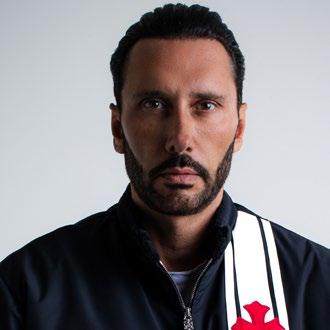



man, go and get what you want to get.
Don’t piss people off. Being polite doesn’t cost a thing, but it goes such a long way. Everyone will remember you for being polite and being a good person.
Markus Schulz, Coldharbour Recordings, Miami
Biggest Inspiration: Larry Levan. I never got to hear him play, but I used to hear stories about him, and those stories inspired me.
Do’s & Don’ts: Don’t ever hit on the promoter’s girlfriend and do thank everybody for bringing you out to their event, because re-bookings is the most important thing.
Cedric Gervais, Delecta Records, Miami
Biggest Inspiration: My father because he took care of my whole family, and I saw him do it for my mother, my aunt, my grandmother, everybody. I just looked up to him all my life. As for my career… Daft Punk was the first inspiration.
Do’s & Don’t: Do make sure to produce a lot of music, and don’t forget to wear earplugs when you DJ – because I forgot! Protect your hearing.
Nick Ditri, Disco Fries, Middletown, N.J.
Biggest Inspirations: I would have never gotten into music if it weren’t for my grandparents and them riding my ass to practice piano. And from there, a huge inspiration for us musically has always been Tiësto. We were lucky enough to do a ton of work together, and he had a huge impact on our career.
Do’s & Don’ts: It’s probably going to be slightly more than one, but do be tenacious. Make quality music and follow up, but don’t follow up [with music-industry people] too much and be overly aggressive with your follow-ups.
Paul Anthony, Gettoblaster, Chicago

Biggest Inspirations: The legends of the house-music game. Since I started listening to music in ’80s, the whole idea and premise of Gettoblaster was to tie in what happened in the beginning of house music to what’s happening now, and have the legends meet the new guys and the new guys meet the legends – because I think the two don’t work unless they both work together.
Do’s & Don’ts: Don’t get discouraged on rejection, because you get 100 no’s before you get a yes, and if you quit, you’ll never make it. Don’t let it bog you down, because this definitely is mind over matter, and people will let their minds deteriorate over the negativity, right? Because there is a ton of it. This is a pop-culture game now at this point. Try to stay in a positive space and do whatever you have to do to stay in that positive space.
GT_Ofice, Caine Records, Miami
Biggest Inspiration: Avicii was definitely a big inspiration in my life. Also, EDX has been a huge mentor, kind of, in the beginning of my journey. And yeah, I love that dude.
Do’s & Don’ts: Do continue to make a bigger network and don’t ever push anybody away. Don’t give up on your dreams, bro. You never know what’s around the corner. Tomorrow’s a new day.
Sickick, Sick Music Universe, Toronto
Biggest Inspiration: I’m super-inspired by Hans Zimmer. I am inspired by my peers in this industry, of course, but I try my best in the most respectful and humble way not to listen to them, because I want to keep my sound different from theirs. I know I’m the type of person that, if I listen to a Skillex album or whatever, my next project will sound like that. So I try to drive inspiration from different places.
Do’s & Don’ts: One do is… make sure you own your masters for as long as you can. That’s No. 1 – that is your value. That is your catalog. Don’t surround yourself with people who make you less inspired to wake up. Make sure you have a team that you can rely on, that you trust.
Paige Lopynski, Bonnie X Clyde, Los Angeles
Biggest Inspirations: My father is probably the first person I would mention. He is the one that inspired me to do music, in general. In the music industry, I absolutely adore Ellie Goulding’s vocals. I think she’s just timeless and extremely talented. And I would have to say Avicii has also inspired me in so many ways. He got me heavily into electronic music – and yeah, they all are really inspiring for me.
Do’s & Don’ts: Do stay authentic to you, and don’t try to copy anyone or compare yourself to anyone.
Daniel Litman, Bonny X Clyde, Los Angeles
Biggest Inspiration: Probably my partner Paige [Lopynski], through the process, because we







spend the most time like bouncing ideas off each other to actually get to the output associated with our art.
Do’s & Don’ts: Do take accountability for yourself. When it’s you, that’s the issue. Take accountability and maybe say that I’m at fault and I was pointing fingers at other people where I should be pointing fingers at myself. Take accountability. Don’t be an asshole.
Tim Clark, Coldharbour Recordings, Las Vegas
Biggest Inspirations: Tiësto, Armin van Buuren, Sasha & Digweed, Markus, Schulz, and Ferry Corsten.
Do’s & Don’ts: Do be driven, and don’t give up.
Jerry Davila, Block & Crown, Puebla City, Mexico
Biggest Inspiration: Purple Disco Machine because we do the same music. We revive the disco music from the ’80s, from the ’90s to be new music. Make music great again, my friend, just music.
Do’s & Don’ts: The ladder is very high, so we have to wait. We have to be patient. We have to work every day. Also, avoid drugs, alcohol, bad habits, and then to keep all the good habits. Do your exercise. Keep focus. Don’t be discouraged.
Brandon Alex, XYST Agency, Old Bridge, N.J.
Biggest Inspiration: A lot of local guys in my area, because a lot of those that I came up in the scene with are now a lot bigger. So there’s people like 4B and others who brought me up to be where I’m at. I started as a promoter, then moved my way up as a DJ and now I own an agency.
Do’s & Don’ts: Definitely always try to do the right thing. Always try to be the best version of yourself. Definitely don’t burn any bridges because you never know when you have to work with somebody again.
Biggest Inspirations: Boris Brejcha. I really love his production style, and he’s a very dedicated artist. Loves his fans. Very good role model for me. Then also my music teacher in high school, Mr. C was a very he taught me that liking weird, random music that other people don’t necessarily like, is like a thing that you should be proud of… because I feel like everyone has their own unique style. And he encouraged me to continue listening to weird stuff like that, even though the other kids in school did not agree. He pushed me.
Do’s & Don’ts: My main do is… 100-percent be yourself and don’t let people bully you into being something else. You’re gonna get bullied, but just stay in your own lane and stick to what you want and what you know and who you are, and that’s gonna benefit you in the end.
Don’t underestimate yourself. And don’t hate on yourself. Don’t prevent yourself from doing certain things just because you feel like you can’t do it, because eventually you’ll find that you can.
Jade Starling, Pretty Poison, New Jersey
Biggest Inspiration: My bandmate, Whey Cooler. Other than him, probably someone like Stevie Nicks, who I was totally in love with when I was a kid. My parents took me to see Fleetwood Mac, and I was totally inspired by her – I thought she was magical. Stevie was just so mysterious and witchy.
Do’s & Don’ts: One do – work your ass off. One don’t – don’t ever give up.
Whey Cooler, Pretty Poison, New Jersey
Biggest Inspiration: John Lennon because he was great songwriter. He had really great outlook on things. I just thought he was the coolest person.
Do’s & Don’ts: Do stay persistent. Never give up. A lot of people are going to tell you no and tell you why you can’t, and they’re the people that you have to prove it to… that you can be successful. Also, be true to yourself. If you show if you have heart and gut in your music and you believe in it yourself, other people are going to follow.
Don’t put too much faith in the social-media aspects of things. At the end of the day, you need to reach a wide audience, and social media is great to get started, but I think you can fall into thinking your little fanbase is all there is. In some regards, maybe that’s all you need. But if you really want to reach everybody, you should try reach everybody by every avenue.
Kastra, Ultra Records, Boston
Biggest Inspiration: My guitar teacher in high school because he got me really involved in music. From him, I learned music theory, which helped my songwriting. He got me started. For artists? Everyone from New Order all the way up to Avicii and Ingrosso.
Do’s & Don’ts: When you’re learning and just starting out, do try to emulate people’s styles and songs. That’s a good way to grow and learn quickly. Obviously, you don’t want to do that when you start releasing your own music, but it’s good way to develop your chops.








Don’t be a jerk. This is a small community. Word travels really fast.
Nikmind, Red Eclipse Recordings, Charlotte, N.C.
Biggest Inspiration: Carl Cox. That was one of my biggest inspirations, and it’s always going to
A do… always keep your focus on the music. And don’t stop making music.
Linney, Various Labels, Los Angeles
Biggest Inspiration: I grew up listening to the great folk singer/songwriters like James Taylor, Carole King, Carly Simon, and I feel like I’ve tried to bring that storytelling into my music and dance music in general.
Do’s & Don’ts: My best piece of advice would be… do keep showing up. If you love what you’re doing, just keep showing up. Don’t be too full of yourself; sometimes you gotta check your ego at the door.
GoodLife, XYST Agency, Jersey City, N.J.
Biggest Inspiration: I’ve taken a lot of inspiration from Alex Juan. Actually, he’s a relatively new Afro-house producer, at least on a bigger scale, and I love his big, emotional, melodic sound. I really look up to him because that’s really the avenue that I’m trying to develop further.
Do’s & Don’ts: Do… just talk to people. Be yourself. Be genuine. Most people can kind of sense whether they’re not being genuine. If you can just be yourself as a good person and just talk to people freely, I think that’s a really big one, because connections are probably the biggest things to get you far. Talent is good, but it’s usually knowing the right people in combination with delivering further after that. And I would say a don’t is… never forget where you come from. I think that’s really further down the line, but it’s easy to kind of lose sight of that as you go through your busy life.
DJ CQQCHIFruit, Lumpen Radio, Chicago
Biggest Inspiration: Growing up in Miami, I would hear radio shows that were live from Club Space or the other clubs from then. But, going back in time, I’d say Alice Deejay.
Do’s & Don’ts: Do respect the history, do your research, and understand the genres and the artists who have created those genres and pay respects. Don’t take yourself too seriously. Stay humble, but don’t stop having fun.
Esther Anaya, Total Smash, Los Angeles
Biggest Inspiration: Jesus Christ. I believe that a lot of the knowledge I have and all the inspiration comes from God, and I always pray before I create some music, so I give it to Him.
Do’s & Don’ts: Definitely do put yourself out there. Find a community. Go support older DJs. Go learn from older people and go find your sound and yourself, and get inspiration from others. Do not be cocky and do not be mean, because this world gives so many turns – and stay humble. Stay true to yourself and do not be afraid. But, do not mess with other people because, once you do, karma hits you.
P.J. Augustyn, Club DJ, Minneapolis
Biggest Inspiration: It was my mom’s experience, actually. She took a job in radio, plugging commercials for the Milwaukee Brewers radio network. But she hated it and quit after two weeks. Then I took her job when I was just 14. That started a long, radio career, and I got to work with Bob Uecker. Thanks, mom.
Do’s & Don’ts: Do stay in your comfort zone. Do what you know, what you like. Try not to do things that are overextending yourself. If you know yacht rock, play yacht rock; don’t try to play Afro-house. Stay in a lane where you feel comfortable.
As a DJ, don’t price yourself out of the market. Know your worth and get the money that you know you deserve. But don’t go crazy asking for money that you know isn’t there.
Oscar Troya, Pool Recordings, Fort Lauderdale, Fla.
Biggest Inspirations: Axwell and Martin Garrix because I’m also into progressive house and bass house.
Do’s & Don’ts: Be yourself. There are copies of DJs everywhere. You know, if somebody releases a successful song, there’s tens of thousands of DJs making the same kind of songs. So obviously, do be yourself. Don’t copy others.
Golob, XYST Agency, Jersey City, N.J.
Biggest Inspiration: John Summit is probably my biggest inspiration. Hearing his older stuff really kind of pushed me into music production. I think he’s a phenomenal DJ, but really makes his money with his productions.
Do’s & Don’ts: Do take advice from a lot of people. I think there’s value in speaking with colleagues, subordinates, supervisors, people in charge of you, people who are with you, people under you. Everybody has a piece of advice to share. I think it’s important to just keep your ears open, and definitely don’t say no. Say yes to every opportunity that people give you. I’ve gotten way further in music and life by just accepting opportunities as they come.


From Immersive Projection Mapping To Live Vjing and LED Screen Visuals — We Transform Events Into Unforgettable Visual Experiences.


Music-synced visuals + live camera feeds for real-time energy and engagement. Transform walls, stages, or decor into living, breathing art with 3D visuals.

Live VJ‑ing Projection Mapping Event Recording LED Screens & Setup
Multi-camera recordings with clean audio, branding, and edits ready for YouTube or promo reels.

Dynamic LED walls or installations, custom-fit for stages, DJ booths, or interactive installations.
Why Halucinated Studios?
• NYC DOE & MBE Certified
• Trusted by brands, festivals, and creatives
• 10+ years experience in high impact visuals
• Fast, professional, and mind blowingly creative
Quick Setup, High Impact
Packages from $800 to Full-Scale Productions
Perfect for Clubs, Concerts, Corporate, Schools & Weddings



By Jim Tremayne
New York City – In 1975, when Joseph Bechor founded the original Rock And Soul store in Manhattan, Gotham was having a tough time, even seeking federal assistance. It was the year of the infamous New York Daily News headline – “Ford to City: Drop Dead.” No bailout was coming, so NYC was on its own.
Bechor was on his own as well. Seeking a better life, he had recently emigrated from Israel alone and he put his heart into this new electronics store. When he realized it could work, he brought over his wife, Shirley, and his daughters. Things would get even better.
Over the years, Rock And Soul evolved into one of America’s most legendary DJ stores. It sold DJ gear of all types from all eras. Plus, it sold tons of vinyl records for hip-hop and dance DJs looking for the very latest jams. Additionally, it sold independent music on consignment from artists and labels that would become legendary

themselves.
This year marks the 50th anniversary of Rock And Soul. Located in the heart of midtown Manhattan, the store has soldiered through all the changes that the DJ-retail world has brought upon it. In celebration of the store’s milestone, we connected with Joseph’s daughter Sharone Bechor, who runs the store now, and her mother, Shirley, to discuss the shop’s unique history.
DJ LIFE: Your parents, Joseph and Shirley, founded Rock and Soul – what’s their story? What did they originally envision the store to be?
Sharone Bechor: My parents emigrated from Israel. My dad was just trying to find a way to build a better life for our family here in America, just trying to make enough for them to survive and bring the family here. The store started as a typical electronics shop on 7th Avenue – very common at the time – with a music section in the back.


DJ LIFE: What was the main Manhattan competition at the time – the Canal Street stores?
Sharone Bechor: Our biggest competitors back then were Sam Ash, the Canal Street stores, and yes, Crazy Eddie, if you remember him! Later came Record Explosion, Discomat, Manny’s – and then, of course, all the shops on 48th Street and Canal.

DJ LIFE: What was the original Rock and Soul store like in 1975? What was it selling?

Sharone Bechor: We used to sell anything that we could – incense, pipes, Ray Bans, you name it. And it was an electronics store, like many others on 7th Avenue in Midtown, selling speakers, receivers, TVs, watches, and cameras. But the music section made up about half of the store. Once it was lucrative enough and my father, Joseph, saw that he could stay afloat, he brought the family over –my sisters and mom were still there.
DJ LIFE: Did that change the store?
Sharone Bechor: When my mom, Shirley, came in, she was really smart about buying music. She made sure we had everything people were asking for, and made sure we had enough of it. Small labels came in that no one knew, and she would wallpaper the walls with their label, test it out, and they were so grateful for the increased business, they would make sure she had the best price, so she could keep selling it and keep it out on display. New artists emerged and they just wanted to be on the wall. She would keep it on consignment, have the DJs that worked there play it, and then, before you knew it, it was a hit. One of the artists was the infamous Wu-Tang Clan. It all started from them bringing their records on consignment, same with DJ Premier of Gang Starr, Mobb Deep, Black Moon, and so many more artists.
DJ LIFE: At what point did the store begin to carry DJ gear?
Sharone Bechor: When records were going out of style and CDs were becoming popular, our clientele didn’t have CD players. And then the record stores stopped carrying records and only carried CDs, so we became the only store that still had records. When people were transitioning to CDs, no one thought about how it would affect DJs, so the DJs each told their friends and told each other that this one store still had records and it was Rock and Soul in Midtown. So once
the DJ community started coming here for records, they started buying not one record, but two records at a time and they started asking for gear, so we quickly changed our electronics from cameras and watches to turntables, mixers, mixing boards and speakers. And then, more and more we started catering to the DJs – buying records that DJs wanted and singles that just came out or hadn’t even been released yet. DJs started coming two to three times a week to make sure that they were up to date with the newest and latest music.
DJ LIFE: From my understanding, when it came to selling DJ gear in its early days, a lot of Canal Street consumerelectronics stores were handling those products – early lines like GLI, Numark, Gemini, etc. The traditional music stores on 48th Street wouldn’t carry the DJ stuff or even know very much about DJ equipment.

Sharone Bechor: We became so specialized in that market that all the DJs were coming to us and telling all their friends about us for records and for DJ gear. To be honest, we didn’t bother ourselves with what other stores were buying or not. We just paid attention to what our customers wanted, and made sure we got it for them. The volume of the customers asking questions indicated to us what we need to buy and to carry, gear-wise. For example, Technics turntables, we were selling like hot cakes.
DJ LIFE: As an early vinyl shop, how much did the 12-inch single – for dance music or hip-hop songs – drive customers to the store? What was that culture like?
Sharone Bechor: Like I said, DJs were coming to the store two to three times a week making sure they didn’t miss out on a new record release. Then, the bigger DJs began coming twice a day – in the morning and then in the evening. Singles were selling all the time and they were buying two of them. We noticed the shift, that people were not buying albums; they were buying 12-inch singles. People would come in, and listen to every single record that would come in. Every record got listened to.
DJ LIFE: The DJ culture really took off right in your store…
Sharone Bechor: Definitely… the DJ culture played a big role in this. When DJs discovered the magic that two turntables and a mixer could create, I don’t think Technics or



A lot.
DJ LIFE: Who have been your best-known DJ customers?
Shirley Bechor: It was a true family business. My husband and I were in the store all day, every day – 10 hours a day. We weren’t in an office somewhere. We were on the floor, listening to what customers wanted. If one DJ asked for something and we didn’t have it and then a second one came in asking for the same thing – I had to have it in the store. That’s why we were different. We bought everything DJs needed because we were talking to them directly, every single day.

Sharone Bechor: Grandmaster Flash, Biz Markie, and Kool Herc were shopping here since the beginning of the DJ scene. Then came Funkmaster Flex, DJ Premier, Mark Ronson, DJ AM, DJ Skribble, Samantha Ronson, even Pauly D. Members of U2. Harrison Ford bought his son turntables and music when he was starting out as a DJ. Elvis Costello, and Diana Krall stopped into the store because they live in the area. Solange Knowles comes in. Erykah Badu rents her gear from us. Alicia Keys and Justin Timberlake, rent their gear from us. Beastie Boys. Jazzy Jeff. QBert. Shiftee. Lords of the Underground. Black Moon. QuestLove. A Tribe Called Quest. Biz Markie. Wu-Tang. Souls of Mischief, Talib Kweli. Kenny Dope. Breakbeat Lou. Mell Starr. Louie Vega. All the heavy hitters of the radio station. DJ Enuff. Scram Jones. Peter Rosenberg. Too many to mention. I’m almost afraid to mention, because if I left someone out, they will call me out on it!
Shirley Bechor: Right, every DJ used to come in twice a day. We’d get 10 to 15 shipments daily. DJs would stop by in the morning, and then come back in the afternoon to see if we got anything new – something they could spin that same night at the club. They didn’t want to play what was already on the radio; they wanted something unique, something fresh. So we tried to get everything we possibly could for them. Even young artists – kids, like the Wu-Tang Clan when they first came in – we’d take their vinyl on consignment and play it in the store to see how people reacted. That’s how we built our reputation – by getting the newest music before anyone else.
DJ LIFE: You had to have a genuine connection with your
Sounds like a lot of DJs gained inspiration from the store and labels really thrived.
Sharone Bechor: A lot of DJs and music artists got their start at stores like ours. They didn’t have access to the labels, so they came to the record stores themselves. The smaller labels, before they got big, didn’t have access to big distribution, so they came to the small stores. Loud Records, Strictly Rhythm, they started their careers here. DJs would be inspired by the other music heads they met in the store or by some small release no one really knew, and made magic from it.
DJ LIFE: You’ve seen the evolution of the product market go from analog/hardware to digital. With seemingly less vinyl demand, how has that impacted your customer base? How do you think it impacted the DJ culture overall?
Sharone Bechor: We were there for the beginning – Final Scratch. And we launched Rane Serato in the store when it first came out, and it totally changed everything, totally changed the game. Made it so everyone can be a DJ, not just the ones who lived, breathed, and dug for music. Customers were coming in less and less often, because they didn’t need to hear the new music anymore. And they didn’t need vinyl.
DJ LIFE: Tough for a store…
Sharone Bechor: But look, that is part of evolving. Over the course of 50 years, we are bound to have to encounter changes. It definitely changed the game. We started seeing customers once a year, instead of twice a day. And then when they bought something, it would be online, and not even from us. I always say, if a part of you will be sad that a place shuts down, you need to buy from that place. I don’t mean buy something every day, but when you are buying something, buy it from your favorite places, the ones you would be heartbroken about, if they closed down.
DJ LIFE: In your time at the store, what products do you recall generated the most excitement from your DJ customer base?
Sharone Bechor: Again, I remember when we launched Serato at the store. That was a crazy moment. And then


A curated expansion to the DJX floor, exclusive to the studio and music production category. It builds the bridge and creates opportunity between DJs and Producers.
THE EDIT covers everything from DAWs to desks, mics to monitors, software to storage, plug-ins to preamps, and computers to cables. From bedroom setups to dedicated home and semi-pro studios, THE EDIT has you covered.

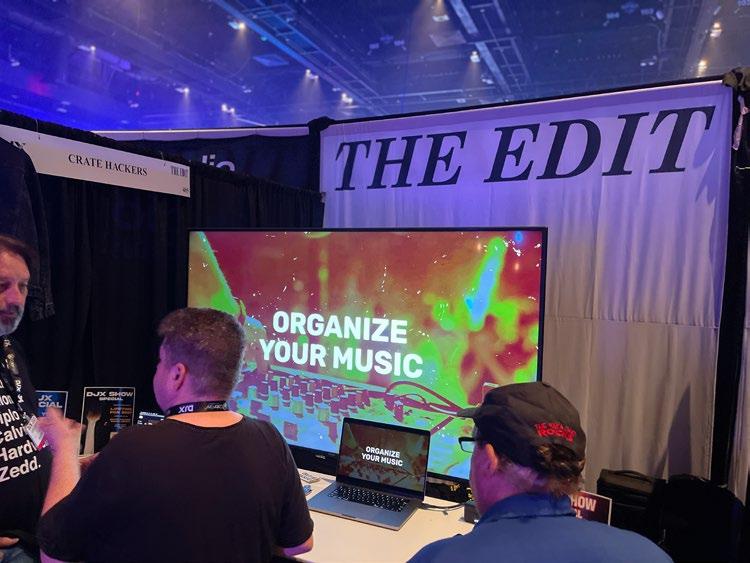






Father/Daughter: Joseph & Sharone.

there was our annual holiday party when Kid Capri gave it a ringing endorsement. My mother was so mad because each customer who bought a Serato SL box was a customer lost in the record department. So, at some point, we had to say to ourselves, how long can we possibly keep this section in the store? The record department almost shut down so many times throughout the years. And look at it now, people crave something tangible, and vinyl is back.
DJ LIFE: How important do you think it is for DJs to have a place to congregate and talk shop, talk music? How did Rock and Soul help facilitate that?
Shirley Bechor: Every day customers and DJs used to come to the store. Most DJs used to have a job during the day and then at night they used to be a DJ. After they finished their job by 5 p.m., they used to come to the store and stay until 7 to talk to each other about what’s in, what’s good, and they used to discuss between all of them.
Sharone Bechor: I think that this is the most important part of what we do: Creating a space for music enthusiasts to congregate and talk about music. We have weekly DJs, and monthly workshops and meet-ups. We are always creating an environment.
DJ LIFE: How important for DJs is a brick-and-mortar shop, as opposed to buying everything online?
Sharone Bechor: So important. Yes, absolutely, someone explaining to you how an item works is a plus… and what the difference between the softwares or styles of gear is helpful. Making sure you have all the connections right – that is something you won’t find when you are buying online. But besides all of that, it’s the experience and the feeling of a music store. That pull, that energy you are doing this job for. Most people don’t make DJing their profession unless they love the feeling or love music. And that feeling you get in our actual store is something you don’t find everywhere.
Not to mention in a brick-and-mortar shop, especially ours, a family business, you know the people and know
they won’t steer you wrong. When you are in a pinch, we aren’t robots, that are just following the rules. You are getting a person on the line who will go out of their way for you. The other day, a customer we know that we haven’t seen in a while, was in a bind. Was at their gig, and was down a cable and some needles and slipmats. We hooked them up, and delivered to their gig within 25 minutes. You can’t get that from a big superstore. When you come into our shop, you will find people who have been working here 10-plus years. Our manager has been here for 35 years. When they buy a controller, we immediately find out what are you plugging it into, what speakers, what computer, to make sure they don’t go home and get started, only to find out they don’t have the right connection. When a person comes in wanting to start DJing, our instructor hooks them up with a lesson, showing them how to get started and gives a lesson on the spot. You just can’t get that experience from buying from online.
DJ LIFE: Quick Business Take: If these tariffs continue, at what point do you believe the DJs will begin to really feel it? Will present stock be impacted? What’s your view at the moment?
Sharone Bechor: Unfortunately, all the prices are going to go up and there’s no way around it. The companies that make the product are all under enormous pressure, and sadly, will have no choice but to raise their prices, making the dealers have to sell at a higher price. They will enforce pricing to be uniform, so there will be nothing we can do. Go visit the actual stores, then we can help you out with better pricing. In general, whenever you are looking for a better price, go to the actual shop. We will always have better margins in our store. Online, we have to account for shipping, web fees, and credit-card fees. If you want a discount, go to the actual store.
DJ LIFE: The store was recently recognized by NAMM for its anniversary. How does a retail shop in New York City survive for 50 years?
Sharone Bechor: The biggest reason we were able to stay afloat is being able to evolve quickly. Do not be afraid of change. I believe you need to learn to be comfortable with being uncomfortable. Because that is when magic happens, when you step out of your comfort zone. Most stores, when their lease is up, or have to move, they close shop. Not us, we find something better. And we grow and we move on. We are very in tune with what people are asking for. Have you seen my mom? She doesn’t know hip-hop music, but she listens to what people are asking for, and orders it for them! When we saw people asking more for professional mixers, we adapted. When we saw the shift in record sales from albums to 12-inch singles, we adapted. When we saw people wanting to buy online, we had to adapt as well. However, the one thing we know you can’t buy online is that feeling, and that is why, when you come to Rock and Soul, it is more of an experience, an energy, and a family.






Detroit – Almost 90,000 fans filled Motown’s Hart Plaza this past May 24-26 for the annual Movement Festival. More than 120 DJ/artists performed on six stages over the Memorial Day weekend. They included a range of diverse acts like John Summit, Horsegiirl, The Blessed Madonna, Jamie XX, MK, Sara Landry, Klangkuenstler, Soul Clap, Dubfire and Patrick Topping.
Detroit-based acts performing at Movement included Jeff Mills, Kevin Saunderson and The Saunderson Brothers, Carl Craig, Stacey “Hotwaxx” Hale, Mike “Agent X” DJ Holographic, DJ Godfather, Stacey Pullen, Octave One, DJ Minx, and several more. It all looked like this:









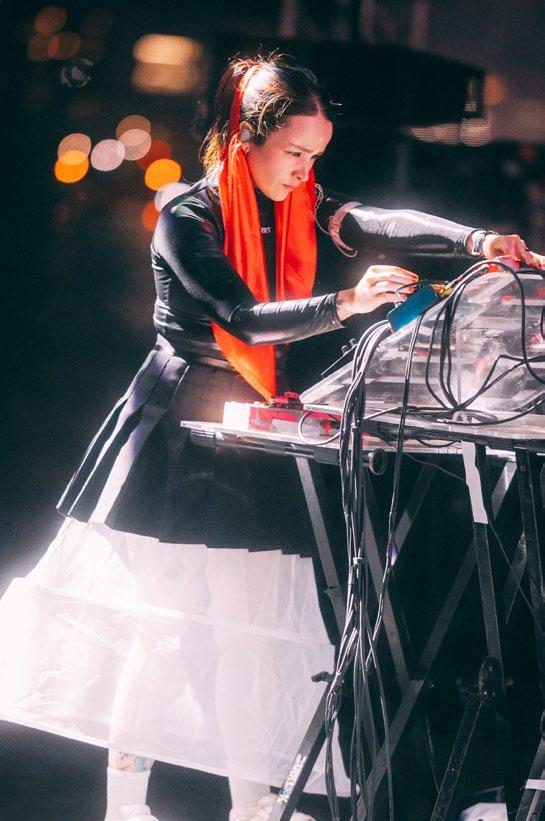


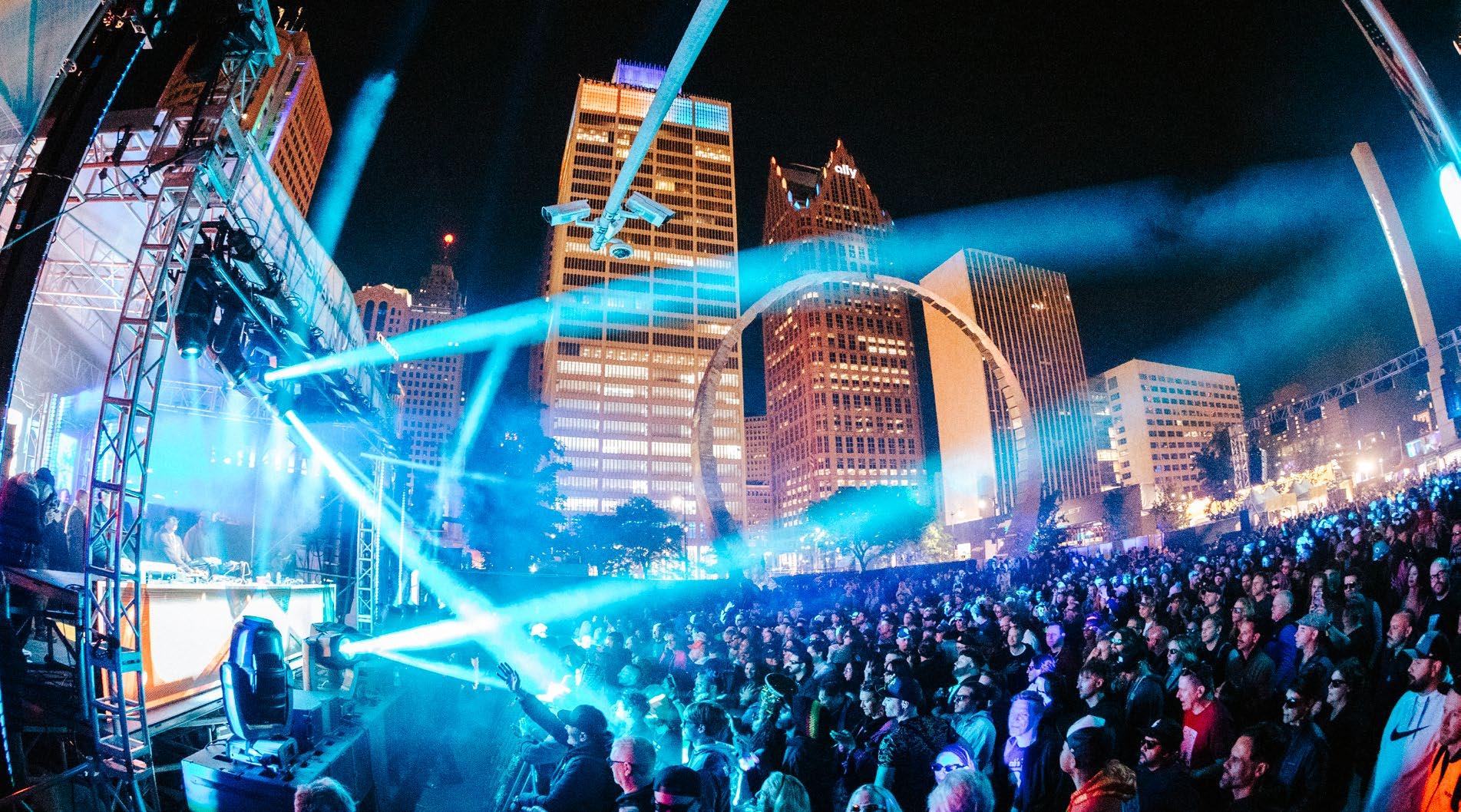


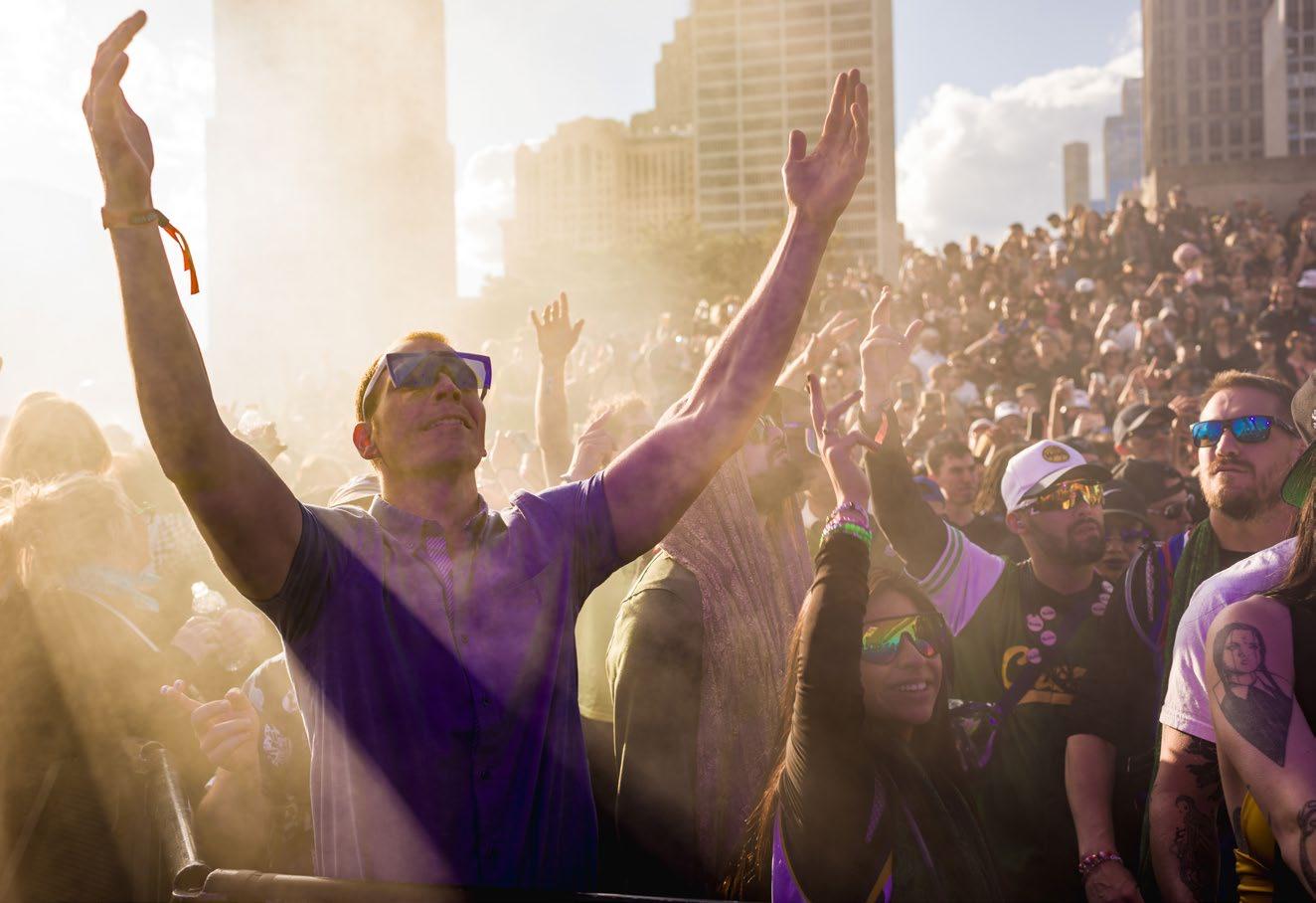





Photos by Insomniac Events

Las Vegas – This past May 16-18, more than 525,000 fans visited the Las Vegas Motor Speedway for Electric Daisy Carnival, North America’s largest EDM event. Produced by Insomniac Events, EDC ’25 presented more than 250 performers including many of world’s top DJs acts, like Tiësto, Kaskade, Armin van Buuren, Martin Garrix, Gorgon City, NGHTMRE, Hot Since 82, James Hype, DJ Snake, Dom Dolla, Sara Landry, Boys Noize, and many more. It all looked like this:



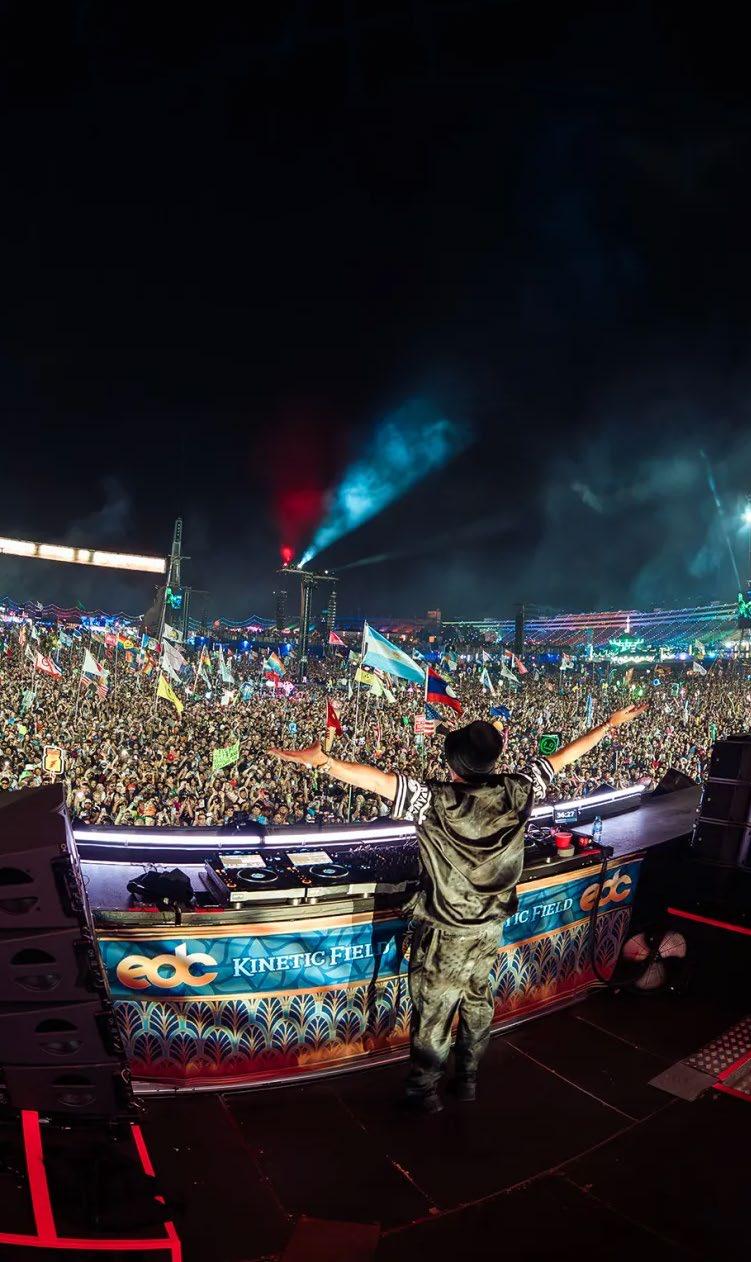

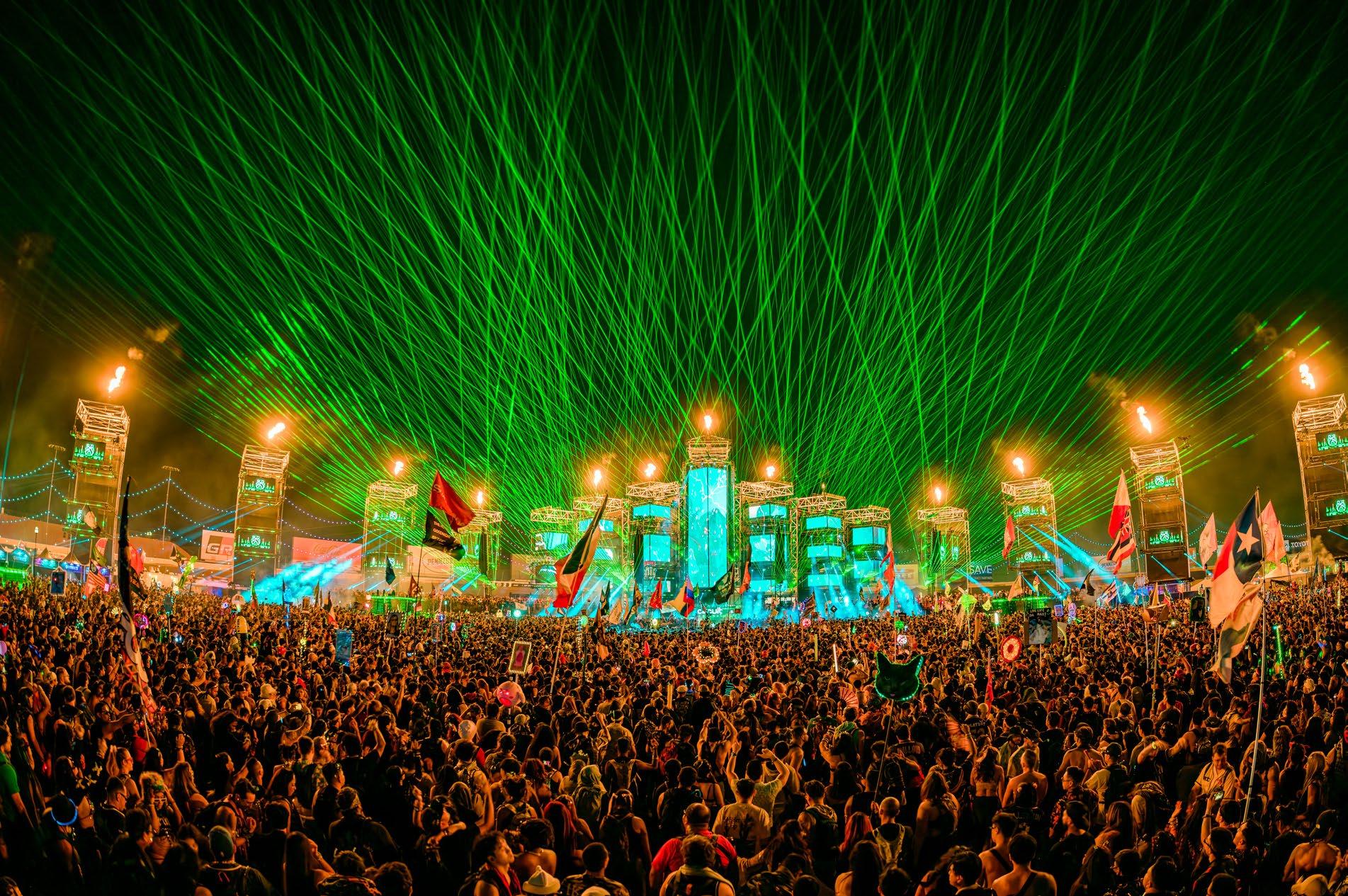
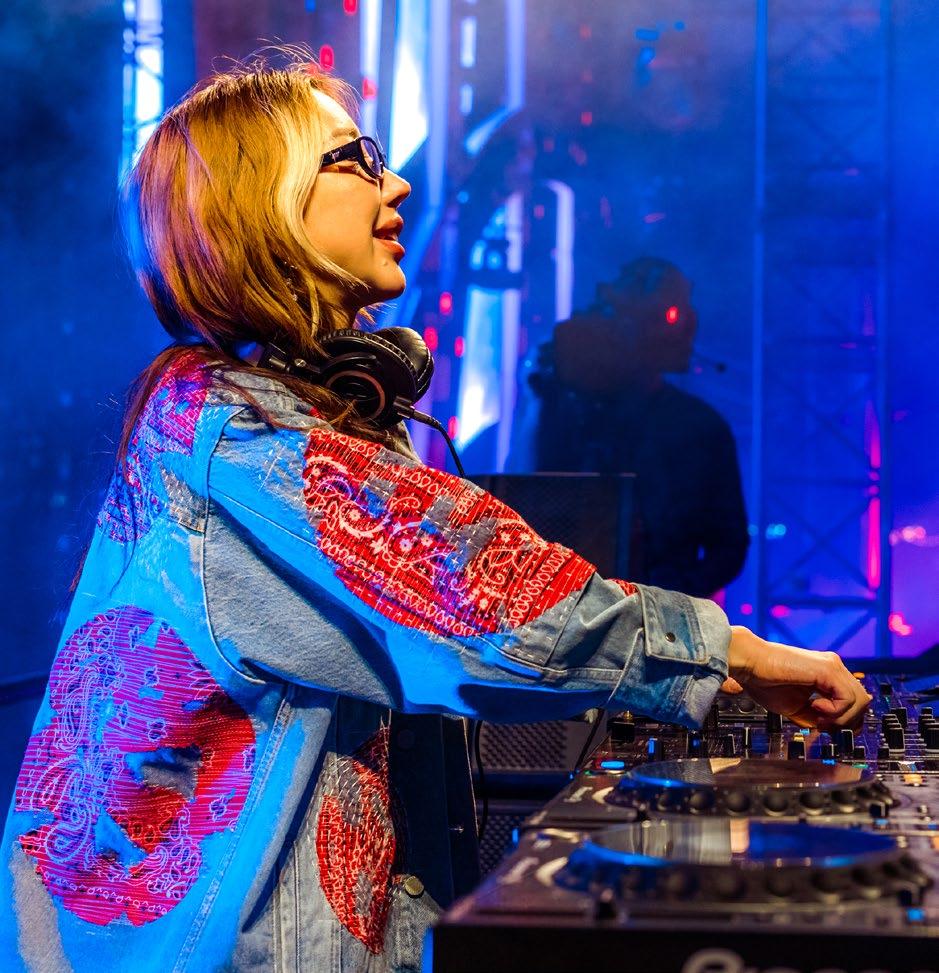







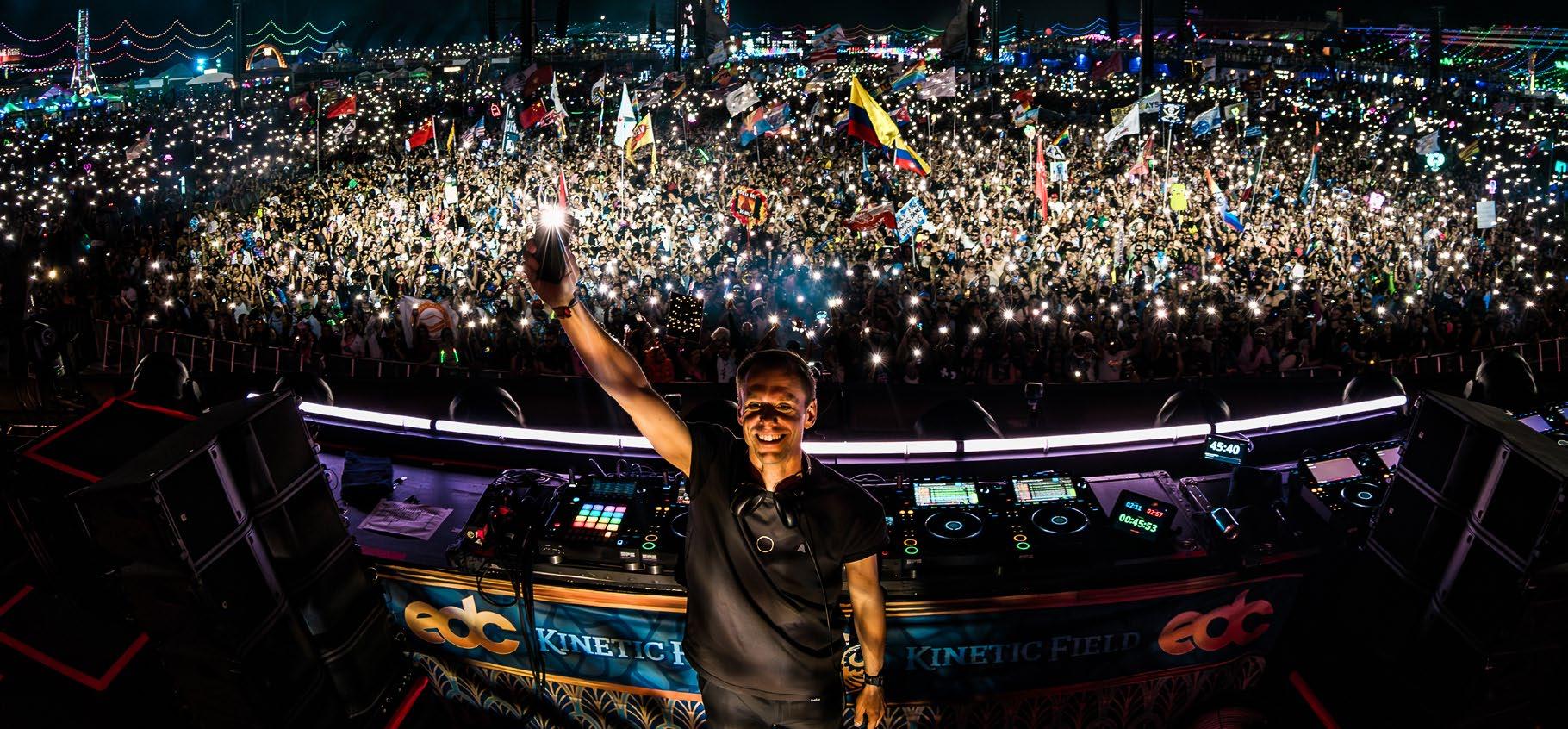

BY JIM TREMAYNE IMAGES FROM [UNVRS]
Ibiza, Spain – Built on the massive space that once held the Ku Club and Privilege, [UNVRS] – purportedly the world’s largest nightclub – opened this past May 30 in the Ibizan village of Sant Rafael de Sa Creu.
Envisioned and built by The Night League, which operates White Island brands like Ushuaïa Ibiza, Hï Ibiza, Playa Soleil, and ANTS, the club (pronounced “Universe”) reportedly spans nearly 70,000 square feet and can accommodate up to 10,000 patrons.
With its Dome that features the “Tree of Life” centerpiece, open-air terraces with views of Ibiza Town, and The Wild Comet club-within-a-club, [UNVRS] is a club like no

UNDER THE DOME: THE TREE OF LIFE

ELROW PARTY: FRANKY RIZARDO GETS GOING.
other. Featuring a custom-built L-Acoustics sound system, the club features mesmerizing LED visuals and lighting, plus acrobats and dancers in its enormous main room.
On opening night, its impressive DJ lineup included Carl Cox b2b Jamie Jones, Joseph Capriati b2b The Martinez Brothers, Michael Bibi, Adam Ten b2b Mita Gami, Ahmed Spins and Carista. In the following weeks, top jocks and brands kicked off their residencies. They included Eric Prydz (Holosphere 2.0), Anyma, Jamie Jones (Paradise: Sands of Solaris), Fisher, David Guetta (Galactic Circus), The Elrow Party, and Carl Cox. It all looked like this:

MASSIVE: ERIC PRYDZ’S HOLOSPHERE 2.0.

CRASH LANDING: [UNVRS] OUTSIDE.

ELROW MADNESS: ILARIO ALICANTE ON THE DECKS.

PRYDZ PARTY: IMMERSIVE HOLOSPHERE 2.0 VISUALS.

SUSPENDED: DANCERS ABOVE THE MAIN FLOOR.

ROWGELIA: ELROW’S PARTY CHICKEN IN ACTION.

CORRIDORS: ONE TRIPPY TRIP TO THE LOO.

CO2 CANNON: ELROW WARRIOR POINTS YOUR WAY.

KA-BLOOEY: CONFETTI RAINS ON ELROW EVENT.

SUNRISE SET: MICHAEL BIBI IN THE EARLY A.M.
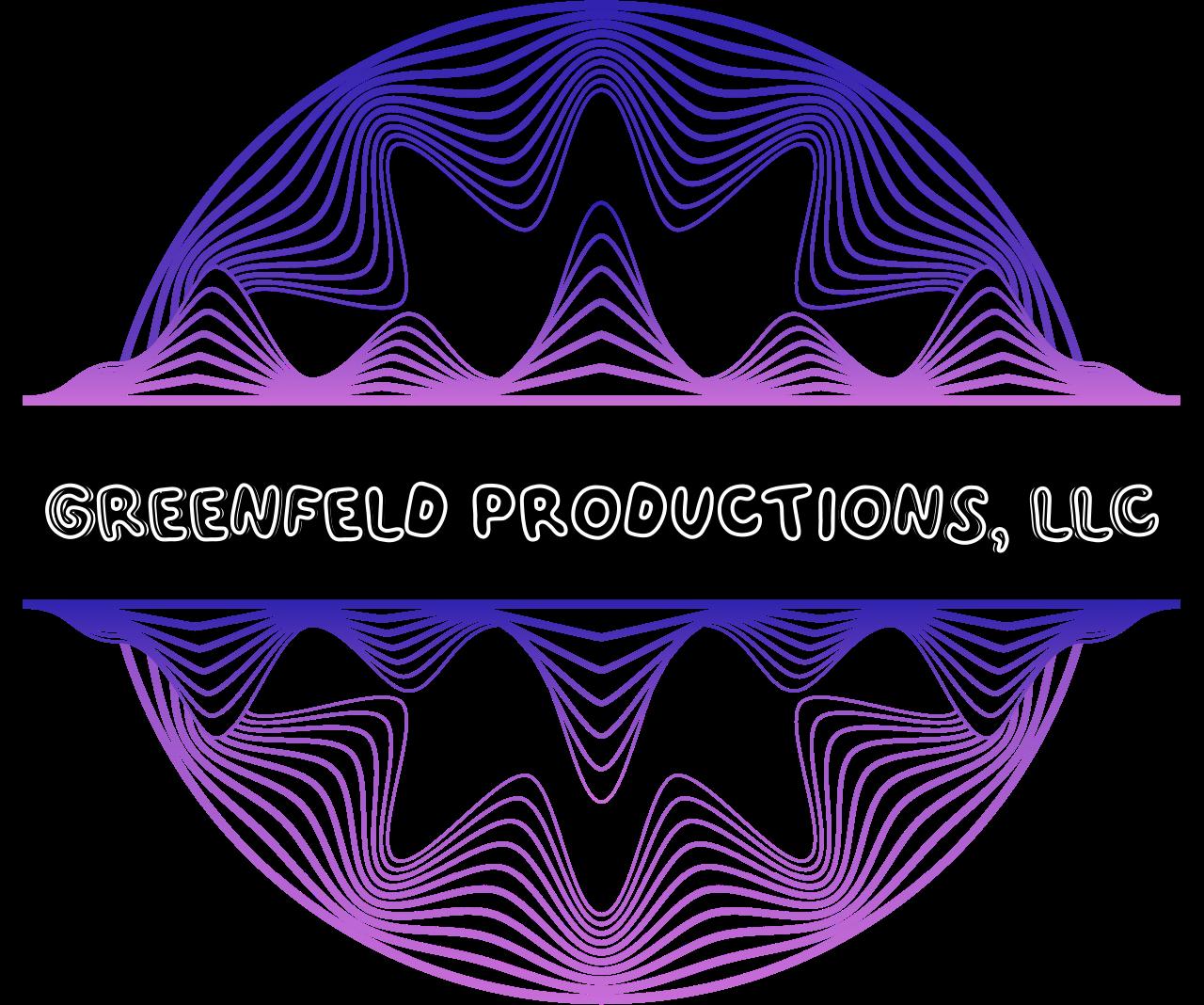

Greenfeld Productions, LLC has been in business since 2012 and is a Washington DC based events and entertainment business offering a variety of services to include DJ’s, lighting and sound, events planning, comedians, entertainment consulting, and so much more. There is no event too large or too small for Greenfeld Productions to handle.
Our latest offering includes a whole branding side of the entertainment business We will be a featured exhibitor at the DJX Show 2025 in Atlantic City where we will provide an opportunity for DJ’s of all skills and experience levels an opportunity to perform at the show, record their sets (audio and video), create EPKs, etc This will be a true takeaway service for show attendees to help grow their brand
By DJ Deets
AlphaTheta’s DDJ-FLX2 has launched into the entry-level market with its relatively affordable ($179 street price) compact controller that offers just enough for someone to master the core tenets of DJing.
Of course, the DDJ-FLX2 will feel instantly familiar to anyone who has used legacy Pioneer DJ products. It feels especially reminiscent of the Pioneer DDJ-200 from a few years back. Importantly, it doesn’t feel overwhelming to users who may be graduating from solely using software or might even have no DJing experience at all.
Stretching only 5-inches wide and weighing under three pounds, it’s one of the most portable and lightweight DJ controllers on the market. It follows the widely used two-deck-and-a-mixer controller layout that’s been the industry standard for controllers for a while now.

Each deck section has a fairly small touch-sensitive jog wheel capable of pitch bending and scratching. Holding down shift and moving the jog wheels activates a search function. One should note that they’re not the smallest jog wheels ever fitted to a controller, but they’re certainly a far cry from CDJs or turntables.
Below each jog wheel are eight performance pads. Calling them pads is a bit of a misnomer – they’re really square-shaped buttons made of hard plastic and click when pressed. Nevertheless, it’s impressive the number of functions they can do. They default into hot-cue mode, but other modes are available, including Pad FX, Loop, and Sampler. To successfully change pad modes, one holds down the shift and the beat-sync button to change between pad modes.

channel comes with 3-band EQ controls, and there’s a color FX knob below the EQ.
Also, the top row of pads light up to indicate which mode is active. This whole process takes some time, so it’ll definitely be tricky to, for example, trigger a hot cue and then immediately begin a loop. I’m glad there is the ability to do different things with the pads (especially since some entry-level controllers only allow hot cues from their pads), but I wish there was a better way to toggle between pad modes.
To the right of the performance pad is a tempo slider. I really like how long they made the tempo slider and the fact that there’s a confident click when the slider is in the neutral position. Notably absent from each deck section are looping controls or any effects control beyond the pad FX. That’s not a dealbreaker, by any means, but certainly worth mentioning.
Moving on to the mixer section, there are two fairly short channel faders – they’re not unusably short, but I did notice they were on the shorter side. Ditto for the crossfader – again, not unusably short but on the shorter side. Each
There is no gain knob, but I never found myself explicitly wishing I had one during my testing. Software auto gain functionality has gotten so good that physical gain knobs might not be as necessary as they once were. At the center of the mixer section, there are buttons to assign each individual channel or the master output to the headphones. In terms of inputs and outputs, there are two headphone jack-style 1/8-inch TRS connectors on the left side of the unit. One is for the headphone output and the other is for the master output. There are two small knobs next to each output to control the level. I’m really glad to see this controller having its own audio output. And, I’m also not mad that the output uses a headphone jack-style connector instead of the traditional RCA connectors.
Headphone jacks are so commonplace these days that it may be easier to connect to various speakers at house parties using a headphone jack and aux cable. Of course, you can always buy a headphone jack to RCA cable for connecting to systems requiring an RCA cable. On the back, there’s a USB-C connector for connecting the controller to a laptop or connecting the controller to a power source, if using a phone via a Bluetooth connection. Next to the USB-C port is a Kensington lock.
The verdict? I really liked my time with the DDJ-FLX2. It’s a compact controller with enough hardware features to get a solid foothold in the world of DJing. Good job, AlphaTheta.

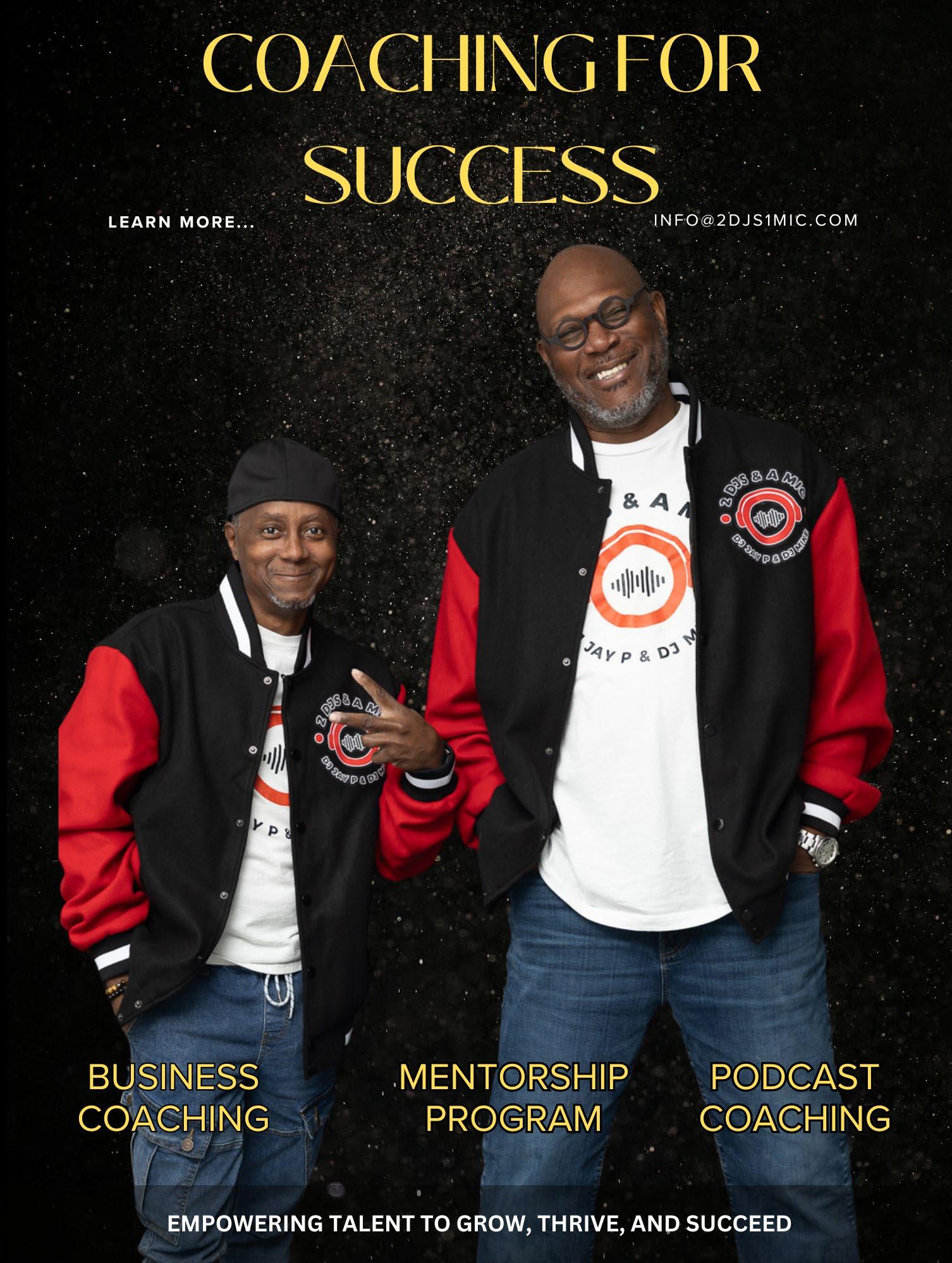
By Mike Márquez
During my run hosting “DJs After Dark,” which I streamed on Twitch and Facebook, and in my current on-air roles at Mix93FM and NEXT Dance Radio, I spent and still spend countless hours wrestling with audio setups. Tangled cables, finicky interfaces, and the constant battle against room noise are all real things.
So, when the promise of a streamlined solution came my way, we can definitely say it caught my ear. Like many content creators, I’ve often found the path from an idea to a clean, professional recording to be more of an obstacle course than a smooth flow. So, when Shure announced the MV7i, a microphone boasting both USB and XLR connectivity and a built-in audio interface, my interest was definitely piqued.
Could this be the elusive tool that simplifies the process without sacrificing quality? With a plethora of mics on my shelf, I was definitely interested in finding out.
Sliding open the MV7i’s box, the first thing that struck me was the familiar, robust feel of Shure engineering. Nestled securely inside, alongside a USB-C cable and a solid-looking mount (a standard 5/8-inch thread, thankfully, so it fit right
Features: App-powered control & multi-track recording.
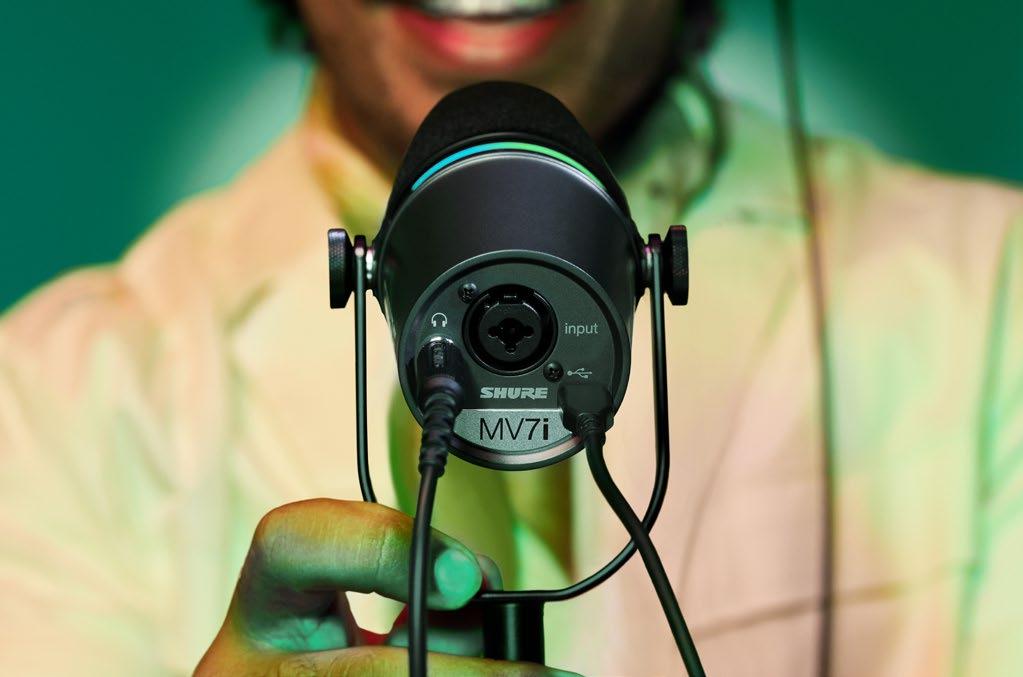
Picking it up, the weight of the all-metal body feels reassuring, suggesting this isn’t some flimsy piece of kit. It has a professional, understated look, reminiscent of its more established siblings in the Shure lineup. The removable windscreen is a thoughtful touch, hinting at its versatility for different recording environments – whether I’m close-miking vocals or capturing a wider sound source.
What truly sets the MV7i apart isn’t just its dual XLR (input) and USB (output) connectivity – a feature that already offers welcome flexibility for transitioning between simple and more complex setups. It’s the integrated audio interface that feels like a genuine game-changer. The idea of connecting external microphones directly to the MV7i, effectively making it a central hub for audio, immediately simplified a mental picture of my oftencluttered desk.

For podcasters who might have guests with their own preferred mics (say, a dynamic for a boomy voice and a condenser for more detail), or for musicians looking to quickly integrate another instrument’s signal (like a direct line from a guitar amp), this built-in brain offers a significant advantage and reduces the need for extra gear.
Furthermore, for those wishing to use condenser microphones, the MV7i offers switchable 48V phantom power, conveniently controlled via the software. And for capturing high-quality audio, the MV7i can operate at sample rates up to 24-bit/48kHz.
Plugging in via USB for my initial tests, the set-up was remarkably straightforward – no driver headaches, just plug and play. Shure’s MOTIV Mix app quickly recognized the microphone, unlocking a surprisingly deep level of control. This isn’t just some basic companion software; it feels like the command center for the MV7i.
Adjusting gain (and seeing the visual meter respond in real-time is a nice touch), tweaking EQ settings from a warm, rounded tone to a brighter, more articulate sound, and monitoring my audio in realtime with zero latency through the headphone jack was all intuitive and easily accessible. I even appreciated the visual representation of the EQ curve in the app, making
it easier to understand the changes I was making.
Importantly, when recording in MultiTrack mode, the MV7i allows you to output both a convenient mono mix and separate tracks for each connected audio source. This provides maximum flexibility in post-production.
Two DSP features that particularly impressed me were Smart Gate, which silences a second channel when no audio is detected, and Real-Time Denoiser, which cuts out unwanted background noise on both channels. In my less-thanacoustically-treated home office, the hum of my computer fan can sometimes creep into recordings. Engaging the Denoiser, for example, seemed to intelligently reduce the volume on silent channels, minimizing that unwanted noise without feeling overly aggressive or cutting off my voice unnaturally. These are two subtle, but effective tools that contribute to a cleaner overall sound, especially during those natural pauses in speech.
Experimenting with the EQ presets within the app, I found it easy to tailor the microphone’s response to my voice. Starting with a neutral setting, I could quickly dial in a bit more warmth for podcasting or a slightly brighter tone for vocal demos. The real-time feedback through the monitoring allowed me to hear the changes instantly, making it easy to find the sweet spot for different applications.
The built-in pop filter also proved its worth. While I might still reach for an external one in particularly plosive-heavy scenarios (if I’m right up on the mic for intimate narration), the MV7i did a commendable job of taming those disruptive “p” and “b” sounds, ensuring clearer vocal recordings right out of the box. It’s one less accessory to worry about for most situations.
Connecting an older dynamic microphone I had lying around to the MV7i’s XLR input was surprisingly seamless. The MV7i recognized it without any fuss, allowing me to quickly switch between the two sources within the app.
This opens up interesting possibilities for recording interviews with different microphone types or even layering sounds from various sources without needing a separate, dedicated audio interface. It genuinely feels like Shure has thought
about the practical needs of modern creators who might be building their setup over time or who need flexibility for different recording scenarios.
The beauty of the MV7i lies in its ability to offer a wealth of features without feeling overwhelming. The onboard controls for volume and mute are easily accessible, and the MOTIV Mix app strikes a good balance between comprehensive control and intuitive design. I didn’t find myself digging through endless menus or feeling lost in technical jargon. The visual feedback within the app, like the level meters and EQ curves, also makes it easy to understand the impact of the different settings.

While the MV7i offers a lot, it’s worth noting that the reliance on the MOTIV Mix app for deeper control means that users will likely want to have it running during recording sessions, especially if they’re actively tweaking settings. Also, while the built-in pop filter is effective, those recording very close to the microphone might still benefit from an external one for maximum plosive reduction, particularly if your recording space isn’t acoustically treated.
Finally, at a retail price of $349.99, it sits in a competitive space, and users will need to weigh its unique features against other options in that range.
The Shure MV7i feels like a particularly strong contender for content creators who value versatility and simplicity. If you’re a podcaster who wants high-quality audio and the flexibility to record with guests using different microphones, this is a compelling option. Musicians who want a straightforward way to record vocals and instruments without a complex interface will also find value here.
Even streamers looking for a reliable and easy-to-manage audio solution that can adapt to different streaming setups should have the MV7i on their radar. It’s a solid investment for those looking to upgrade their audio without getting bogged down in technical complexity.
Microphones with built-in interfaces have been around, and all of them have appeared to be a “do-it-all” microphone. However, the Shure MV7i manages to blend the quality you expect from Shure (SM7B) with a genuinely useful and well-integrated audio interface. It simplifies the audio workflow without compromising on sound quality or flexibility. It eliminates the need to carry interfaces and switchers with you on the road. With just the microphone and the included nine feet of USB-C cable are almost all you need.
For someone like me, who appreciates a clean setup and the ability to adapt to different recording scenarios, the MV7i feels like a valuable ally in the ongoing quest for clear and professional audio. It’s not just another microphone; it’s a thoughtfully designed tool that empowers creators to focus more on their content and less on the technical hurdles.
At $349, it represents a significant step up for those serious about their audio, and the integrated features, including multi-track recording and switchable phantom power, offer a compelling reason to consider it.

By Jim Tremayne

Tampa, Fla. – If you’re attending a sporting event in Florida’s Tampa Bay area, odds are that Matt Dodge is behind the decks.
In fact, over the years, Dodge has worked all types of contests – collegiate, high-school, and professional, including gigs for University of South Florida teams, IMG Academy teams, NHL’s Tampa Bay Lightning, and MLB’s Tampa Bay Rays and Atlanta Braves. Booked through Street Laced Marketing & Promotions, Dodge’s sports gigs keep him plenty busy, but he also handles more typical mobile gigs, from bar work to weddings.
At DJX ’25 this Aug. 12, Dodge will join a panel of sports jocks for “Stadium Jocks: Spinning for the Team,” a seminar that will discuss all aspects of the gig. We caught up with the busy sports spinner to find out how he does it.
DJ LIFE: Where did you grow up and what got you first interested in music?
Dodge: I was born in Maine, but essentially grew up in Venice, Fla., about an hour south of Tampa. Music was always playing around the house growing up. We’d have the radio on during dinner, for example, so I naturally absorbed a lot of music. Even today, I’ll have older people ask me how I know certain classic songs when I play them – it’s because they were part of my upbringing.
DJ LIFE: How did you get into DJing?
Dodge: In high school, I was really into

TV production. I went on to college and earned a degree in film production.
My friends and I would create parody videos of MTV shows like “Cribs,” but what I loved most was editing. I used a program called Sony Vegas to edit videos – and I eventually started mixing a cappellas and instrumentals to build “mega-mashups.” This was over 20 years ago, but DJing remained a hobby until about 10 years ago, and I’ve been full-time for the past five years. Back then, I only made mixes at home – never live.
DJ LIFE: How many events do you do each year?
Dodge: Between 150 and 175 gigs a year. These range from in-game sports to local bars, family-friendly events, and a handful of weddings.
DJ LIFE: What’s your percentage breakdown of events?
Dodge: Sports, 40-percent; bars, 30-percent; all-ages/family events, 25-percent; weddings, 5-percent.
DJ LIFE: You work with Street Laced, a marketing, promotion, and event company in Tampa. How has that relationship benefited you?
Dodge: Street Laced Marketing & Promotions is unique in Tampa because they have a presence with nearly every major pro and college team in the area. Any time there’s a big sporting event in town, organizers consistently reach out to them for
On Mic: Zerambo has become a frequent public speaker.
professional DJ talent. Street Laced is where I would say I get 80-percent of my gigs from, including all my sports gigs. The rest – like city events, Florida Aquarium USF non-athletic events – I get on my own through word-of-mouth or people hear me at an event and inquire.
DJ LIFE: How do you and Street Laced get the word out and market events and services?
Dodge: I use Instagram and Facebook mostly. Street Laced promotes through the same and their official website
DJ LIFE: As it relates to spinning for sporting events, what are your responsibilities?
Dodge: For each game, I handle live mixing during pregame using player requests or similar tracks to set the vibe. Once the game begins, I use Serato and 7 Point Audio to manage music for crowd prompts, hype moments, games during breaks, and background beds as needed.
DJ LIFE: For which teams do you spin?
Dodge: I’m currently the in-game DJ for the University of South Florida, handling football, men’s and women’s basketball, and volleyball. I’ve also filled in for USF baseball and lacrosse. Outside of USF, I’ve filled in for the Tampa Bay Rays and performed both inside and outside of Amalie Arena for the Tampa Bay Lightning. I started
my sports DJ career with the Atlanta Braves at their spring training facility. I also do in-game for IMG Academy’s high school team in Bradenton.
DJ LIFE: For a DJ, how does working the sporting events differ from each other?
Dodge: While background beds of music can often be universal, each sport has its quirks. Women’s basketball allows music during any dead ball; men’s hoops does not. Volleyball demands a hype sound every single time they score — you have to be ready instantly. A Tuesday 1 p.m. baseball game feels chill, whereas a Friday night throwback game needs energy And there’s one thing that’s always consistent: Clean music only.
DJ LIFE: For a DJ, what are the differences between playing a football stadium, a hockey arena, and a baseball park?
Dodge: For me, the biggest difference is where I’m physically located during the event, which varies depending on the stadium or arena. If the space is available, I prefer to bring my full DJ setup so I can mix live as often as I’d like. However, some venues place you in a control room with limited space, where I can only use a laptop. In those situations, I feel more restricted in terms of creativity and flexibility.
DJ LIFE: What was the biggest learning curve for you doing these events?
Dodge: One of the biggest challenges was figuring out what to play when the opposing team goes on a run or takes the lead – and I have to play something. You don’t want to hype up the other team, but you also can’t play something too downbeat or depressing. Striking that balance –keeping the energy up while reading the room and the moment – definitely took some time to master.
DJ LIFE: What DJ gear set-up do you usually use?
Dodge: I currently use the Rane Performer 4-channel controller, which gives me the flexibility to constantly mix live using Serato on one computer. I also run 7 Point Audio through a third channel and control it with a fader for quick transitions between custom triggers and live mixing. A monitor speaker is a must in my setup. I crank it up because there’s always a delay between what I’m playing and what echoes back in arenas or stadiums.
DJ LIFE: What are the considerations

that your teams have for the fans? What do they expect from you?
Dodge: With USF, I’m very fortunate that they allow me a lot of creative freedom when I DJ. For example, they recently moved me and my full setup to the student section at basketball games – that shift alone helped me connect with the students more directly and gave the overall energy in the arena a noticeable boost. I’m always mindful of the variety in the crowd – from college students to longtime season-ticket holders. I try to strike a balance between newer and older music, when appropriate, so that everyone in the venue hears something they enjoy.
DJ LIFE: When you’re spinning Major League Baseball games with the Rays, what’s the process for each batter’s walk-up song?
Dodge: I’ve only filled in for the Rays on occasion, so I don’t have a definitive list of all-time walk-up favorites. But I can share one challenge I’ve encountered with baseball: You’re at the mercy of the players’ walk-up song choices. For example, a player might choose a slow or low-energy track – and if the player before them just hit a triple and I’m coming off a big hype moment, it can really kill the momentum. To manage that, I try to keep track of which players have slower walk-ups and, if possible, let the hype track ride until the last moment before they step into the box.
DJ LIFE: What songs have been the big for you so far in 2025?
Dodge: I would say in 2025 that the three songs that work the best right now are “Nokia” by Drake, “Pump It Up” remix with Endor and Black Eyed Peas, and “Sunshine (My Girl)” by Wuki. All of these songs are very upbeat and familiar, so they work at almost any event.
DJ LIFE: What’s the most fun part of spinning for sporting events?
Dodge: It never gets old taking a relatively quiet crowd and turning it up to 11 with just the right song. Another favorite moment is playing a big singalong track, cutting the volume, and hearing the crowd keep it going a cappella. Those moments give you chills –it’s when you really feel the connection between the music and the fans.
DJ LIFE: How has the gig changed in recent years?
Dodge: In the sports DJing space, I haven’t noticed a dramatic shift – it’s remained fairly consistent. However, with DJ technology becoming more accessible and easier to learn, a lot more people are trying to break into the scene. In my opinion, it’s the DJs who are truly creative – the ones who bring something unique to the table –that will stand out and go the furthest. If someone’s only motivation is to get famous, this probably isn’t the right path for them.
DJ LIFE: Aside from sports, what events do you most enjoy and why?
Dodge: I really enjoy doing DJ battles. I’ve entered into seven total. I took first place five times and runner-up the other two. I love doing college bar gigs – they give me room to get creative with live wordplay and crowddriven sing-alongs, which are some of my favorite moments. Beach gigs are always a good time, too, with the laidback energy and fun vibes. I also really enjoy niche sets, like yacht-rock events, where I get to dig a little deeper into my library and play tracks you don’t normally hear out. Those specialty gigs let me tap into different styles and moods that keep things fresh.
DJ LIFE: Where do you see yourself in five years?
Dodge: I’d love to travel more, and I’m excited to do that through opportunities with The Marker Agency – a company related to Street Laced. In five years, I hope I can look back and say I’ve DJed in a long list of cities and states I haven’t been to yet. Another goal of mine is to play a festival-type event – at any level. That experience, being part of a larger production and energy, is something I definitely want to check off. Also, in just a few years, USF will have its first on-campus football stadium – and I absolutely can’t wait for the opportunity to DJ there.

By Jordan St. Jacques
This past April, I was configuring all the email lists and drip campaigns for the recently launched National Proms. As I did so (with the phone ringer turned off and the headphones blasting some good trance), it occured to me that most DJ companies to this day still don’t make use of the pure power that effective email marketing and automation can give your business. So, for this DJ LIFE entry, I offer a refresher on how to set up and configure your email efforts:
The Set-Up
In order to even begin emailing, there are a few extremely important I.T. aspects for you to consider: Domain. You have to ask yourself what domain you want to be sending your emails from. Most beginners would just use their main email address (that is, if your main URL is djxyz.com then you would blast from, say, info@djxyz.com), which is a mistake. If anything goes wrong in one of your blasts and you end up getting black-listed on spamhaus.org or similar, then you’ve ruined the email deliverability of all of your emails from this domain, not just the email blasts. It’s much better to buy a complementary, yet similar domain to blast from (such as djxyznews.com as per the above example), so that if you get reported for any reason and the domain name becomes ruined, it’s no bother to swap in a new one and move forward. Platform. There are many solutions available for you to choose from, and even solutions that enable you to host your own email newsletter platform. I’ll go over a list of options in Appendix A for online choices, and also go over something below called Sendy in case you want a DIY solution that offers you some serious benefits over the big email platforms… namely less restrictions and lower costs.
DNS. To prevent spam, all the big email providers enact strict adherence to DNS records for SPF-DKIM-DMARC having their values set properly these days. Of course, many hundreds of DJs who use a leading DJ company organizer ran into those problems in early 2024, and learned the hard way about those DNS settings. Email newsletter delivery also requires that you pay attention to this issue as well. Failure to do so can and usually does result in emails ending up in the spam folder… or worse… not being delivered at all.
Once your technical aspects are taken care of, you’re ready for next steps. Now, before you start typing up email text and configuring your HTML, you should take an hour and plot out your strategy for email marketing. A little bit of time spent on coming up with your email master plan will save you time and keep you focused once you get into the details later on.
Some questions to ask yourself…
What information do my potential customers care about?
How many emails is too much or too little?
What content can I offer that will prompt potential cus-
tomers to sign up for the email newsletter list?
What can be automated vs. what needs to be sent out manually?
One of the best DJs out there for emailing that I’ve worked with before is Ken Cosco from A Touch Of Class (ATOC) in Boston. Without giving away all his secrets, here’s an overview of his email strategy:
List-acquisition strategy revolves around the bridal-show season.
The mechanism is a form on his website that auto-adds emails to his list, which he and his team funnels through a QR code combined with great customer service at the bridal shows themselves.
Once a user signs up, there is a modest, yet strategic drip campaign that takes the user through bridal show season, including a giveaway to visit the ATOC booth at the second big bridal show of the season. These emails rotate between informational and promotional, so as to both educate the client on how ATOC is the best choice for their event as well as prompt users on what’s available to them as they decide on what kind of entertainment they want to procure for their wedding.
Most importantly, all of Cosco’s emails (both drip and manual) are geared towards booking a Zoom videocall. Getting in front of the client on that videocall is the key for the entire process for Cosco, who then takes over personally to book the event. His close rate, once the videocall takes place is extremely high, hence the reason for the videocall-centric strategy.
When bridal show season is over, Cosco reverts to a once-per-month newsletter that he types up manually and sends out.
Your most important choice when setting up your list(s) is whether to set up one master list or a series of smaller lists that are more targeted. My personal choice is to use one master list, as it can be far more convenient when you want to send out an overall company newsletter. For those of you wishing to have the ability to send targeted niche email blasts to certain customer groups, this is still very much doable through using Segments.
For my own set-up for National Proms, I have a vendor sign-up form (see here ) that has a custom field called
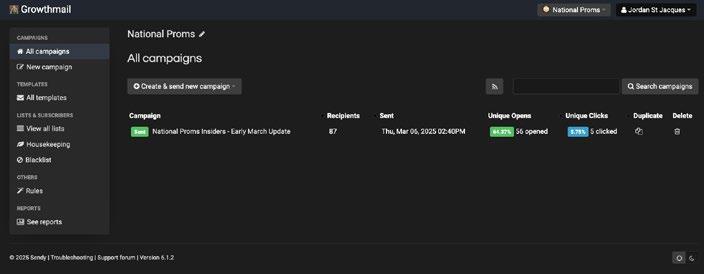
you’ll see the main vendor sectors within the prom industry. When filling out the form (feel free to fill out the form yourself and submit), that choice of Business Type then automatically assigns the email from that signup to a Segment that matches the choice in that field, resulting in a list of Segments within the master list that looks something like this. We only have our internal beta testers on here so far, but you can see we’ve started on DJs just this week.
Using this sort of segmentation gives DJ companies the ability to send both all-user blasts for general company announcements, as well as targeted email blasts for your various niches such as brides blast, mitzvah blast, corporate blast, prom blast, etc.

The effective use of drip campaigns is a great way of automating email delivery, and, as mentioned above, is a vastly overlooked opportunity that most jocks don’t make the effort to put in play.
With a well-thought drip campaign in place, you can avoid about 70- to 80-percent of the sales work by having emails sent out automatically when a user signs up on your list.
In my use-case for National Proms, I use a seven-day drip campaign (Day 0 to Day 6) to send an intro on the various aspects that make up our prom-marketing packages. Day 0 is an intro, Days 1-5 are informational, and then Day 6 is where we get into sales and provide the call-to-action. Take a look here:

For DJ companies, here are the emails that you should consider putting into your own drip campaign:
About your company
About your gear
About what your company does to prepare for an event
About your protocols, including what happens should a DJ be unable to get to a gig
About your performance, etc.
Essentially, create and schedule an email within your drip campaign for every topic you think is worthwhile mentioning, but isn’t necessarily important enough to spend videocall time discussing (unless the client asks about it, of course).
Once your drip campaign has completed, you still have all your users on your email subscriber list, of course. Don’t ignore them, it’s important to continue to send emails to your list at least once a month going forward. Content suggestions are as follows:
Feature your recent gigs, with photos and a brief write-up on how the event went.
Go over one of your premium packages, and point out how the event experience will be enhanced by making the bigger investment.
Offer a monthly special of some sort.
Link to all your socials and YouTube.
Some last-minute things to know about email metrics:
Average Open-Ratio for the DJ industry ranges from 20- to 60-percent. It’s higher during bridal-show season, of course, and then starts to decline as brides start to book the DJs for their weddings.
The Subject Line determines the open ratio. Try doing some A-B testing with different Subject Lines to see if one style obtains better results than another.
The email content determines the Click-Through Ratio. Again, try for some A-B testing if your Click-Throughs aren’t up to par.
If you have Unsubscribes over 3-percent, that’s the danger zone.
If you have Spam Complaints from 0.1- to 0.2-percent, you’re running a risk of getting your account closed.
Pay attention to these metrics, and tweak your email content if your numbers aren’t getting results for you.
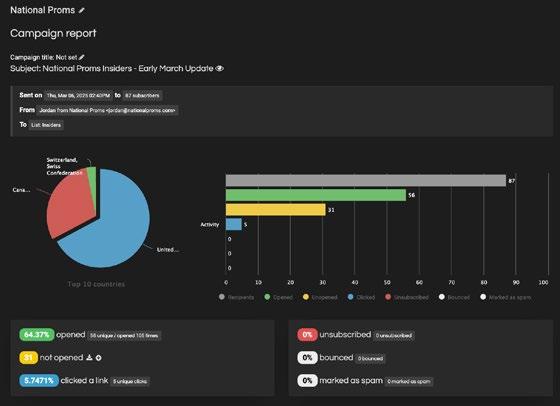
For more indepth reading, click here to read a great article on email psychology. Remember, don’t neglect your email marketing, as it’s still the No. 1 way to reach customers. Combined with some well-thought automation, you’ll save a lot of time as well.
In no particular order, here are some prominent email newsletter platforms that are available to you:
MailChimp
Constant Contact
AWeber
SendFox
Sendinblue
Emma
Also, pay special attention to Sendy , which I use every day, and have based my screenshots above on.
Jordan St. Jacques is the President/Lead Digital Marketer at Digitera.Interactive in Ottawa, Ont., Canada. He’s also part of the Author Collective from National Disc Jockeys.





AlphaTheta and Sandisk have launched the high-performance Sandisk DJ Flash Drive, created with on-the-go DJs in mind. Together, the companies are addressing demanding professional-DJ workflows, and the frequent need to transfer and access large music collections through powerful, durable, and reliable storage solutions. Compatibility tested and optimized for Pioneer DJ and AlphaTheta hardware and rekordbox software, the Sandisk DJ Flash Drive gives users flexibility and confidence when creating, storing, and transferring their sets. Formatted with FAT32 for easy-use right out of the box, the unit’s available in two storage capacities (512GB and 1TB) with both USB Type-C and USB Type-A connectors, and it features speeds of up to 1000MB/s read and 900MB/s write. The product comes with a free 3-month trial to rekordbox’s DJ Creative Plan, enabling DJs to access Vocal position analysis/display, RMX effects, exporting songs from Edit mode, and video playback.
AlphaTheta Corp. 2050 W 190th St #109 Torrance, CA 90504 (424) 488-0480 www.alphatheta.com
AIAIAI has introduced TMA-2 DJ Wireless – the world’s first headphones specifically designed for wireless DJing. With its ultra-low latency wireless technology, the headphones deliver a delay-free experience for precision beatmatching and cable-free mixing. Coupled with over 25 hours of battery life, the headphones offer uninterrupted performance for lengthy sets. TMA-2 DJ Wireless deliver professional-grade sound, tuned for powerful bass and clear treble, with high sound isolation to cut through the noise of any environment. Designed with durability in mind, the TMA-2 DJ Wireless features a robust yet lightweight construction that ensures long-lasting comfort during extended sets. With TMA-2 DJ Wireless, anyone who purchased AIAIAI’s TMA-2 in the last decade can simply upgrade their speaker units and transmitter. This allows for adoption of the latest technology, while reducing electronic waste through AIAIAIs commitment to one headphone for life.
AIAIAI Audio Studiestræde 31 1455 Copenhagen Denmark (45) 30 72 40 70 www.aiaiai.dk
Germany’s Reloop, distributed Stateside by American Music & Sound, has released a series of Premium turntable and vinyl accessories. They include: Reloop Premium 3-IN-1 Record Care Set, which features a 200ml cleaning spray, anti-static microfibre, and a silicon label protector; Reloop Premium Carbon Fibre Anti-Static Brush for deep-groove cleaning; Reloop Premium Stylus Brush for elimination of dirt and distortion; and Reloop Premium 12-inch Vinyl LP Outer Sleeves (100 pieces) for protection of vinyl collections.
Reloop/American Music & Sound 310 W. Newberry Road Bloomfield, CT 06002 (800) 431-2609 www.reloop.com
JetPack, makers of a variety of protective bags for DJs, have introduced the Pulse, a multifunction, polyester cross body bag. Useful for everyday lifestyle applications as well, the Pulse’s versatile compartment can fit multiple items such as a headphone, jump drive, mini hard drive, cell phone, or camera and mini tripod, or for everyday use, your phone, wallet, keys and battery bank. The front pocket is customizable with your own logo, and a back pocket offers easy access. The Pulse features an adjustable shoulder strap and a cable pass-through on backside for easy charging on the go. In addition to multiple zip-up pockets, it also features a specific pocket for an air tag or tracking device.
JetPack 320 E Dyer Rd Santa Ana, CA 92707 (714) 553-8236 www.jetpackbags.com
Native Instruments has released Circular, a polyphonic sequencer that transforms a single note or chord progression into rhythmic soundscapes. Circular can jump from sketch to score in seconds, drawing out rich and emotive cinematic sequenc es. Circular utilizes four independent layers, each a canvas for modulation. Control pitch, filter, and effects in real-time, creating motion-rich scores with unparalleled speed and depth. Every sound was designed with polyphonic aftertouch in mind, making for an expressive experience on Kontrol keyboards, and other controllers that support poly AT. The library has over 160 sound sources, ranging from felted pianos and prepared guitars to hybrid synths and bowed metal. Circular’s diverse palette encourages exploration, blending soft and harsh textures, acoustic and synthetic elements, and familiar and strange sounds. Add your own samples to transform them into evolving sequences.
Native Instruments North America 5101 Santa Monica Blvd Ste 8 Los Angeles, CA 90029 (866) 556-6487 www.native-instruments.com

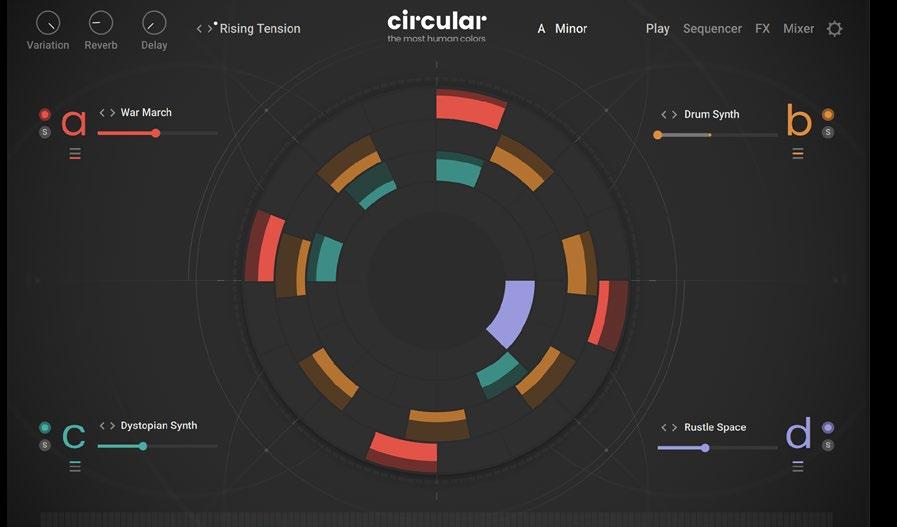
Arturia has released MicroLab mk3, its latest ultra-compact MIDI controller. MicroLab mk3 offers a new design, a high-quality slim keybed, intuitive controls and professional music-making software included. Combining portability and quality, MicroLab mk3 lets users transform any space into a musicmaking studio. MicroLab mk3 is the perfect blend of compact design and inspiring features – the ideal setup for beginner producers, mobile music makers, and home-studio enthusiasts alike. Plug in and start playing instantly. Launch sounds in Analog Lab, use Chord Mode to create harmonies with a single key, shape performance with touch strips and connect a sustain pedal for added expressivity – all with seamless USB-C integration.
Arturia USA 5776-D Lindero Cyn Rd #239 Westlake Village, CA 91362 (33) 4 38 02 05 55 www.arturia.com

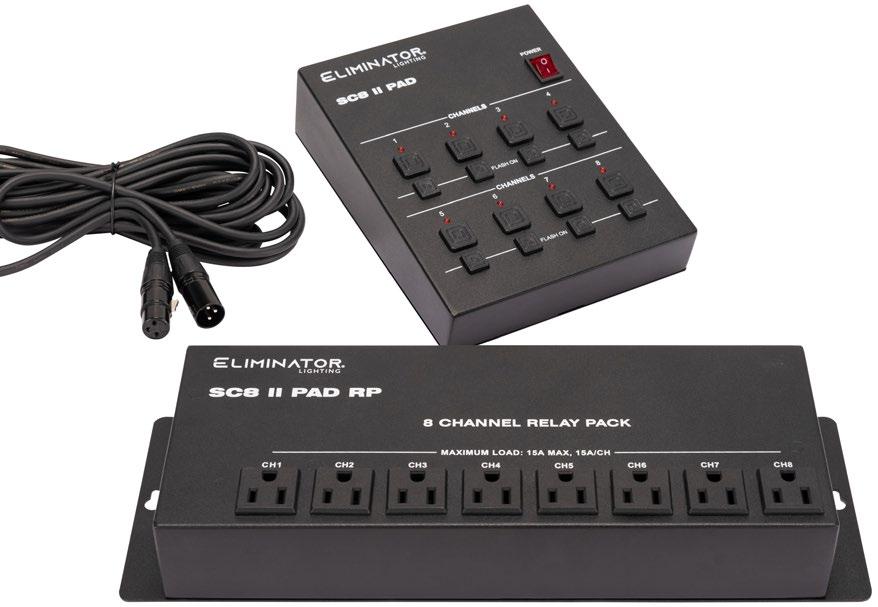


Eliminator Lighting has released the SC8 II Pad System, a control solution for standalone lighting and effects equipment. It features an 8-channel relay pack combined with a separate remote control interface, allowing efficient cable management and convenient power switching. It is ideal for permanent installations in bars, nightclubs, and other entertainment venues as well as for use by mobile event companies and entertainers. Offering a total load capacity of 15 Amps, the SC8 II Pad RP (relay pack) features eight Edison socket power outlets. Power is supplied by a trailing cable fitted with an Edison plug and it is fitted with both side mounting brackets and an M10 threaded mounting hole, allowing for both permanent installation and temporary rigging. A standard 3-pin DMX cable is used to connect the relay pack to the SC II Pad control surface, and a 25-foot cable is supplied with the system.
Eliminator Lighting 6122 S. Eastern Ave Los Angeles, CA 90040 (323) 316-9722 www.adj.com
Evermix has released the Evermixbox5, a new portable recording and livestreaming device for DJs and musicians. The Evermixbox5, the latest iteration of its award-winning Mixbox hardware features re-engineered hardware, delivering a higher level of quality and robustness designed to meet the demanding needs of live streaming and recording. In tandem with the hardware upgrade, Evermix has completely redesigned its Evermix Pro app, which allows users to record professional-level audio and stream live video simultaneously. DJs and music artists will continue to enjoy seamless integration with SoundCloud and Mixcloud, while also gaining the ability to stream from the app to YouTube, Twitch, Facebook, and even custom URLs. A suite of innovative editing tools is also included, with plans for further enhancements to empower artists in mastering, distributing, and monetizing their performances.
Evermix 22 Ash Avenue London, U.K. 2E17 1HS (44) 7947811703 www.evermix.fm
The Roland SH-4d Desktop Desktop Sythnesizer has expanded its creative potential with Version 2.0. The free upgrade gives electronicmusic producers new sonic capabilities with two expressive new OSC Models, pattern chaining for streamlined performances, and serious workflow refinements. The STEP oscillator model offers step-based LFO modulation to produce dynamic movement within tones – from rigid, classic analog step sequencer-inspired phrases locked into the groove to experimental soundscapes with curves, swells, bleeps and bloops. The HARMONIC oscillator model offers rich, layered sounds with a classic drawbar organ layout – prime for creating essential house bass tones, bell-like chimes, deep pads, and powerful organ sounds with hands-on control of four harmonically tuned drawbars. Workflow refinements include: Pattern Chain for streamlined handsfree performances; System-Level FX options; Quick Overwrite for saving tone and pattern data; Undo/Redo function; New Sub-Step options; and Extended MIDI control.
Roland 5100 S. Eastern Ave. Los Angeles, CA 90040 (323) 890-3700 www.roland.com











VocoPro has launched Streamer-Live-Wireless, a new wireless package for streaming content creators. With the ability to perfectly stream vocals or spoken audio to any social-media platform, the Streamer-Live-Wireless is equipped with everything needed to stream or record audio – professional wired and wireless microphones, more than 20 sound effects, singing and chat settings, and even an adequate auto-tune effect. Just connect to the USB input to the smart device or laptop to easily record and stream. System includes: Streamer-Live all-in-one USB interface with sound effects and vocal effects; Commander digital wireless microphone and wireless receiver; microphone stand and light ring.
On-Stage/The Music People 154 Woodlawn Rd Berlin, CT (800) 289-8889 www.on-stage.com
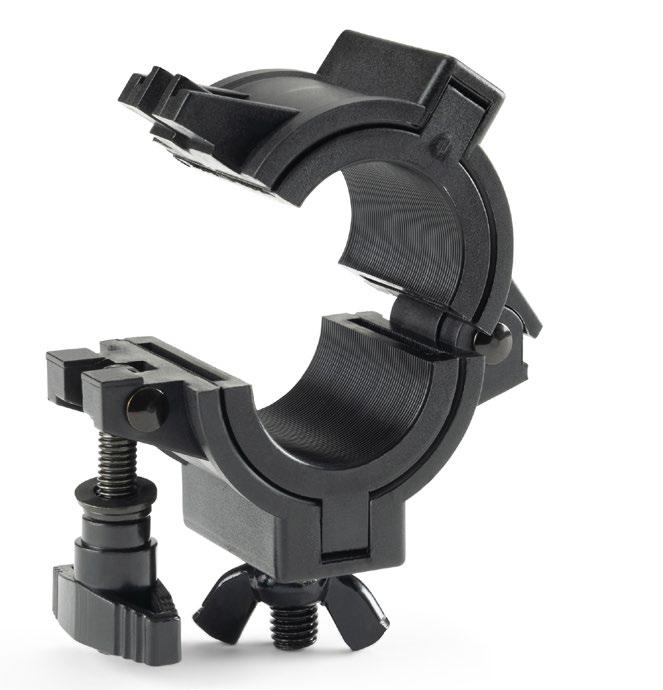
On-Stage, a brand of The Music People, has released the LTA9900 Lighting O-Clamp, which completely encloses truss and lighting-stand tubing of various sizes to securely mount light fixtures. Lighting equipment is fastened to the clamp’s integrated bolt with an included wingnut for a solid, dependable connection. With its 28-pound weight capacity, the clamp delivers more than enough strength to support a wide range of lighting effects, including PAR cans, LEDs, spots, lasers, projectors, washes, and moving heads. The hinged clamp opens wide, making it easy to wrap it around tubing during attachment. Once closed around the tubing, the clamp locks firmly in place with an ergonomic tightening knob. While the clamp itself snugly fits around 2-inch tubing, two adapters are included that also enable tight-fitting use with 1-inch and 1.5-inch tubing. These adapters are simply inserted and snapped into the clamp opening to effectively make the opening smaller for use with smaller tubing.
On-Stage/The Music People 154 Woodlawn Rd Berlin, CT (800) 289-8889 www.on-stage.com


Mixware brand Decksaver has released a new set of protective covers for a wide range of DJ gear and electronic instruments. They include covers for products from: AlphaTheta (DDJ-FLX2, DDJ-GRV6 and XDJ-AZ); Ableton (Move); Denon DJ (Prime Go+); Korg (Microkorg 2); Native Instruments (X1 MK3 and Z1 MK2); Oberheim (TEO-5); Sequential (Take 5); And Union Audio (orbit.2 LE/LE FX, orbit.4 LE/LX and elara.4). The collection sees the Decksaver range grow to over 460 covers. Currently, Decksaver covers are the used for gear protection in elite clubbing establishments across the globe, including Fabric, Ministry Of Sound, XOYO, Ushuaia, Pacha, Amnesia, Café Mambo, Home in Sydney, and Womb in Tokyo.
Black Panther/Mixware 11070 Fleetwood St., Unit F Sun Valley, CA 91352 (818) 578-4030 www.mixware.net















GLP has introduced its MATRIX Series – a modular cluster system that allows multiple frame-based fixtures to be mechanically connected into seamless, custom lighting arrays. Leading the way is the MATRIX Eye, a high-power LED blinder (available in 2-light and 4-light configurations) equipped with efficient RGBAL LEDs and GLP’s iQ.Gamut color algorithm, offering vivid colors and premium white light with excellent color rendering. Its characteristic dimming curve replicates the behavior of traditional tungsten blinders, delivering an old-school look and feel with all the benefits of modern LED technology. The MATRIX Eye offers an attractive price-performance ratio, fast ROI, and high efficiency for rental operations.
GLP German Light Products Inc. 16170 Stagg St. Van Nuys, CA 91406 (818) 767-8899 www.glp.de
ADJ’s Accu-Cable brand has introduced the Tour Link Series of 5-pin DMX cables. Designed for lighting pros, DJ/event production, and integration markets, these tour-grade cables combine premium zinc diecast connectors with superior copper wiring to deliver performance, durability, and ease of use. Available in 3-, 5-, 10-, 15-, 25-, 50- and 100-inch variants, each Tour Link cable has its length clearly laser-engraved on the tail of each plug. Also, 3.5-inch transparent heat-shrink tubes at both ends provide strain relief and added protection, while an included hook and loop strap allows for efficient cable management. Each Tour Link cable features a precision-engineered 5-pin SCMF5-BG (female) connector at one end and a matching 5-pin SCMM5-BG (male) connector at the other, both housed in a robust zinc diecast shell for extended durability and heightened reliability.
Accu-Cable 6122 S. Eastern Ave Los Angeles, CA 90040 (323) 316-9722 www.adj.com
Kali Audio has released the SM-8, an 8-inch model in the company’s top-tier Project Santa Monica (or SM-Series) line of studio monitors. The SM-8 is a 3-way monitor with an 8-inch woofer, and a 4-inch midrange with a coaxial 1-inch metal dome tweeter. Like Kali’s IN-Series loudspeakers, the SM-8 is an acoustic point source, and special care has been taken with the unique geometry around the midrange to ensure a seamless transition to the edge of the speaker. This gives the loudspeaker an ideal directivity characteristic, resulting in an engrossing stereo image where details are lifelike and crisp. Off-axis lobing that is unavoidable in 2-way loudspeakers is virtually eliminated in the SM-8. The transducers are similarly precision-engineered for high dynamic range, smooth response, and low distortion. The woofer design has been refined, and incorporates features that reduce magnetic flux modulation, bringing distortion down dramatically.
Kali Audio 201 N Hollywood Way #212 Burbank, CA 91505 (818) 433-7171 www.kaliaudio.com










“
DAVID MORALES & BLONDEWEARINGBLACK
DIRIDIM
Following their recent collaborations, the legendary David Morales and Ibiza-based singer/songwriter blondewearingblack reunite here. Loaded with bold brassy and string hooks, backed by raw, soulful vocals, this one’s another DIRIDIM winner.
– Curtis Zack
Ben Westbeech & RAHH
Glitterbox
Here’s the third release from Ben Westbeech’s album, Everything Is Within You, and the third single where Glitterbox has supplied a killer remix. This time it’s “Aeroplane’s Motion Extended Mix” with a superb deeper-house interpretation of a class song.
– Curtis Zack
“PRAYER”
CHANEY
Toolroom Records
Sundays get a steroid injection with CHANEY’s latest on Mark Knight’s label. When both sinners and saints hear those robust rhythms and loopy gospel shouts, they’ll twirl their prayer cloths sky high. With a nice run of previous releases on KooKoo, D4 D4NCE, Skint, Armada, and Cr2 under his belt, CHANEY’s punched another strong notch with this one.
– Joe Berinato
“SHOUT”
Vernessa Mitchell
Quantize
It’s pretty standard that any song released on Quantize will be a first-rate soulfulhouse effort – and this latest single is no exception. With this wonderful vocal from Vernessa Mitchell and topnotch production from DJ Spen, we have something here to shout about.
– Curtis Zack

“LOVE
REMIX)
The Joneses Cosmos Music
Here’s another terrific effort from the Spring Revisited Project, which takes old cuts from the Spring label and gets today’s producers to give them a twist. On this offering, Dave Lee does his usual sublime polishing for The Joneses, and the endresult “Extended Disco Mix” is a timeless piece of dancefloor music.
– Curtis Zack



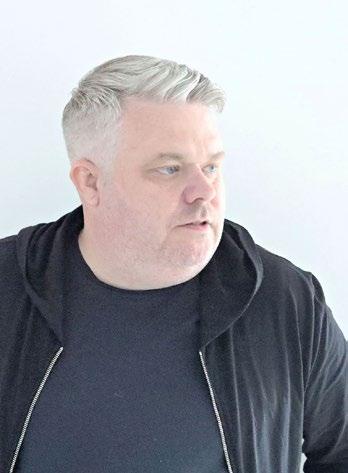
“FEEL ALIVE”
Mark Di Meo & Rightside
Electronic Nature
House producers Mark Di Meo & Rightside hit the dancefloor G-spot on this one – and the G is for groove. Radiating with positivity, “Feel Alive” is crafted with precision by two producers deeply rooted in the genre. All the builds, drops, tempo, melodies and vocal clips are in the right place, with more than enough rizz for a proper indoor/ outdoor get-down.
– Joe Berinato
“DO IT FOR THE SOUL”
Yooks & Ellis Aaron Infinity
This is arguably the biggest Yooks track to date, as he teams up with Ellis Aaron for a great song here. Wicked keys, some mesmerizing vibe hooks and a great vocal give this one all the right ingredients.
– Curtis Zack
“KEEP ME ON THE DANCEFLOOR” (KOLTER REMIX)
Riva Starr feat. Harry Stone
Snatch! Records
Taken from Starr’s latest album, Keep Me on the Dancefloor, a collection full of dope rhythmic romps, this title cut really caught our ear. One of six tracks Starr did with crooner Stone, this one delivers a deliciously pouty vocal and gets some extra panache with Kolter’s soul-stirring remix. Keep an eye out for tracks from this superb LP.
– Joe Berinato

“RISE UP”
Electronic Youth & Matt Early
Sexy Trash
Here’s a dose of righteous and uplifting house music from Matt Early and Electronic Youth. The classic mix leads with chunky piano and a big vocal, while on the flip there’s a deeper alternative for those late-night dancefloor moments.
– Curtis Zack
“YOU’RE NEVER TOO YOUNG” (REMIXES)
The Cool-Notes
Dafia
Originally a 1984 release from the Brit-funk band, this heavy groover gets a fresh makeover some 40 years later, and it sounds as fresh as ever. House jocks will love these mixes come from disco don Moplen, DoctorSoul and Dafia label owner Mannix.
– Curtis Zack


■ Gary Canavo masspooldjs
■
■ Lobo/Bass Record Pool
■ North East Record Pool
■ Mixx Hitts Record Pool ■ Ritmo Camacho Record Pool
